同济大学C B卷答案
《线性代数》同济大学第四版课后答案
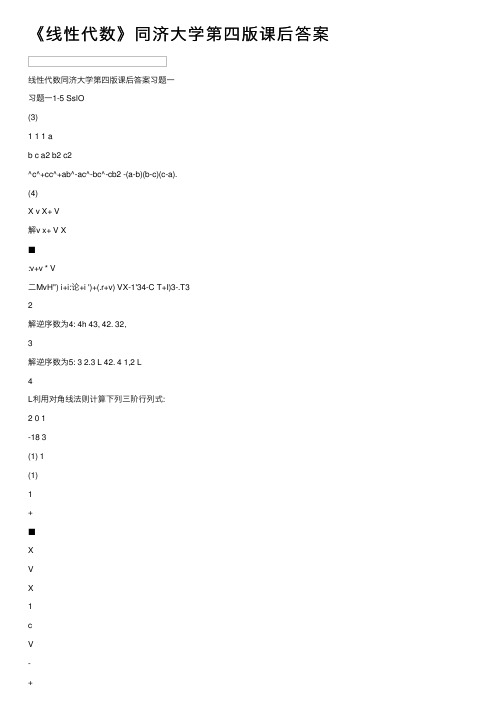
《线性代数》同济⼤学第四版课后答案线性代数同济⼤学第四版课后答案习题⼀习题⼀1-5 SslO(3)1 1 1 ab c a2 b2 c2^c^+cc^+ab^-ac^-bc^-cb2 -(a-b)(b-c)(c-a).(4)X v X+ V解v x+ V X■:v+v * V⼆MvH") i+i:论+i ')+(.r+v) VX-1'34-C T+I)3-.T32解逆序数为4: 4h 43, 42. 32,3解逆序数为5: 3 2.3 L 42. 4 1,2 L4L利⽤对⾓线法则计算下列三阶⾏列式:2 0 1-18 3(1) 1(1)1+■XVX1cV-+VT1⽅沪=3.n (.Y+>)-i^3- 3.T2=-2(.?+V^⼯按⾃然数从⼩到⼤为标准次序.求下列各排列的逆序数:(1)1 23 4(2)4 13 2(3)34 2 1(4)24 1 3(5)1 3 …(2沪1) 2 4 …O);(6)1 3 ?… (⼒—1) (2?z) (2n-2)…* ⼯(1)解逆序数为0解逆序数为3: 2 1.4 1.4 3-(5)解逆序数为观驴:32(1 个)5 2,5 4(2 个)7 2, 7 4. 7 6(3 个)(”1)2, 011)4, (”1)6,…为(”1)(”2) (n-1 个)(6)解逆序数为乃(『Li):32(1 个)5 2,5 4(2 ^t) (2n-1)2, (2n-l)4, (”1)6,…、(2/L1)(2/L2)(n-l个)42(1 个)6 2,6 4(2 个)(5)2, (2M)4, (2n)6,…,(2n)(2n-2) (n-1个)3.写出四阶⾏列式中含有因⼦GU723的项.解含因⼦①畑的项的⼀般形式为(-])%的冰X町其中帀是2和4构成的排列,这种排列共有两个,即24和42.所以含因⼦a^a23的项分别是(-1 )衍1似23他刃44⼆(⼀1 )^11^32^44=-^!凶曲的轴(⼀1 )%1攸曲琢也⼫(T )%1⼝滋34偽⼫&1也刃曲42?4. 计算下列各⾏列式:4 12 4(iho 5 2 0; 0 1172 14 1 (2) ? ¥ ? i ;⼀ ab ac ae(3) bd ⼀ cd de cf -ef *94 -1 109 9 10— 1 2 -20 0 —2 =0-[0 3 14 勺+扭3 P 17 143+ 4O 42021Ci0 00 —1 0 0 -i1 c o -1 d-1230411100上q42 07 202112 5 141100解\170200-1-2102 02 4 9-36172023 15119-9-O--00-0 0 4 23 011-12 0「-310—12 3 O 4 1210■1-12 O解\1-ab ac ae-bee 解bd -cd de =acif b -c eif 灯-叮b c -ehl 1 1 / =adfbce 1-11 = Aabcdef |1 1 -1 (4)l+c/b a 00+此2〔1+甸 a0)(—严才打⼀冷55.证明:cP ab b 1(1) 2a c/+b 2b 1 1 1=(?-/>)3, 证明a obb \c 2-c A ⼔2 ab —R ⼣—⼚F2r/ a+b 勿 2z? b-a 2b-2a 1 1 1 | GT 11 0 0 cix+bv av+bz ciz+bx v v zc/y+bz az+bx ax+by-(q 3+b 3)y ⼆ x az+bx ay+bv av+bz z A VA --!A-oo 1<7 o1 c - 1Ty ⼀o d -l oo0 1+ab cioo 1〃15 B-loTooad \+cd 0n 计呼豐严⽫cdTLab-ci 1 b-a l^-a 2 2b-2a⼆@-a)(b-氓件 J(⼚Tp证明ax+bv av+bz az+bx civ+bz az+bx cix+bv■6C +bx ay+by ay+ bzx ciy+bz ciz+bx y ciy+bz az+bx=a v1az+bx ca+bv / ■<+b z az+bx ca+bv⼆ax+by ay+bz x ax+by ay+bz .x ay+bz z v⼆ciz+bx y az+bx x■JV g+by⼆crx+bv v V v av+ bzilr-'x y z y z x=a3y⼆x+b3⼆Y yz x y\x v zX V⼆,v V z-d y ⼆Y +⼣V S Xar ⼆X V ■■<⼆H ⼆x\z x va2(“+1)2 (c+2)2 (n+3¥⑶b2 (〃+l『0+2)2(b+3Y=0;c2 (c+1)2 (c+2)3 (c+3)2 d2 (H+l¥ (d+2)2 (〃+3⼙—1—iu CM⼨*-+scP-£cl J1+冷£r +Krl E + w S +U ;+-+gI+吕C(E+P)令+⼷)N+m"(E ) c (cl+9) 泾⼗ q)+0 N+q)(R £1bz)2i47/2(5)10 0 b(b-ci)0 b 2(b 2-a 2) c 2(c 1 d-a d(d - a) )d 2(d 2-a 2) 1 1 =(b - a)(c - a)(d-a) b _ c b-a1 c-a c(c ⼀ a)2-a 7-(b ⼀ ci)(c ⼀ ci)(ci ⼀ ct)5b 2(b^ra)c 2(c-\-ci)d 2{d-Va\ R 1 1 6 c-b d-b 0 c(c-b)(c+b^d) d(d-b)(d+b+a)-(b - a)(c ⼀ c)(" - a)(c — Z?)(rf- b)1 1 咚+b+a) d(d+b+ci)oo ⼆X“~h(7 [T 丫+ * … ⼗亿科证明⽤数学归纳法证明.当⼼2时"2⼆诊⼗g+%命题成⽴?假设对于(7L1)阶⾏列式命题成⽴.即⼑刑_1=* ?+⼗岛_2⼯+馮_”则及按第⼀列展开更有—1 0 ■…0 2-1 OO2⼆也门乜(-1严上卫⼆1 1 …⼆xQ 起⼀1+。
高等数学c教材答案同济大学
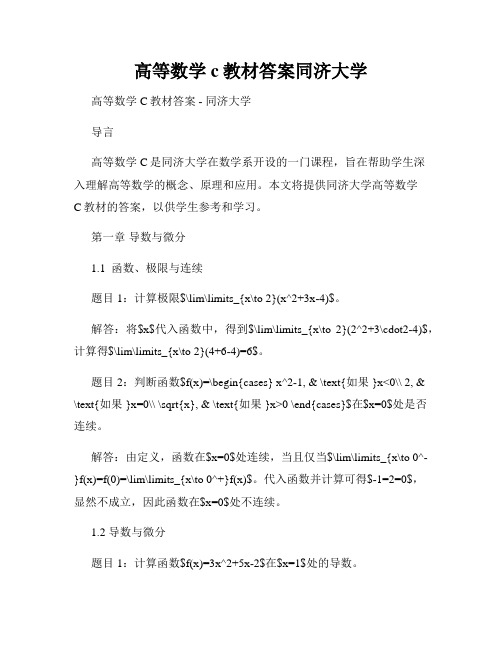
高等数学c教材答案同济大学高等数学C教材答案 - 同济大学导言高等数学C是同济大学在数学系开设的一门课程,旨在帮助学生深入理解高等数学的概念、原理和应用。
本文将提供同济大学高等数学C教材的答案,以供学生参考和学习。
第一章导数与微分1.1 函数、极限与连续题目1:计算极限$\lim\limits_{x\to 2}(x^2+3x-4)$。
解答:将$x$代入函数中,得到$\lim\limits_{x\to 2}(2^2+3\cdot2-4)$,计算得$\lim\limits_{x\to 2}(4+6-4)=6$。
题目2:判断函数$f(x)=\begin{cases} x^2-1, & \text{如果 }x<0\\ 2, & \text{如果 }x=0\\ \sqrt{x}, & \text{如果 }x>0 \end{cases}$在$x=0$处是否连续。
解答:由定义,函数在$x=0$处连续,当且仅当$\lim\limits_{x\to 0^-}f(x)=f(0)=\lim\limits_{x\to 0^+}f(x)$。
代入函数并计算可得$-1=2=0$,显然不成立,因此函数在$x=0$处不连续。
1.2 导数与微分题目1:计算函数$f(x)=3x^2+5x-2$在$x=1$处的导数。
解答:根据导数的定义,函数$f(x)$在$x=1$处的导数为$f'(1)=\lim\limits_{h\to 0}\frac{f(1+h)-f(1)}{h}$。
代入函数并计算可得$f'(1)=\lim\limits_{h\to 0}\frac{3(1+h)^2+5(1+h)-2-(3-5-2)}{h}$,进一步计算可得$f'(1)=\lim\limits_{h\to 0}\frac{3h+3}{h}=3$。
题目2:判断函数$f(x)=\begin{cases} x^2, & \text{如果 }x\neq 0\\ 0,& \text{如果 }x=0 \end{cases}$在$x=0$处是否可导。
同济大学高等数学b教材答案解析

同济大学高等数学b教材答案解析由于高等数学B教材涵盖广泛且涉及内容较多,因此本篇文章将着重为读者提供对该教材中习题的解析和答案,并按照章节对各个部分进行分类解析,以便读者更好地掌握相关知识。
第一章:多元函数微分学本章主要介绍多元函数微分学的基本概念及其应用。
在习题部分,涵盖了多元函数求导、隐函数求导和参数方程求导等题型。
第二章:多元函数积分学本章主要介绍多元函数积分学的基本概念及其应用。
习题部分主要包含了定积分、多元函数的积分、换元积分法等题型。
第三章:向量代数与空间解析几何本章主要介绍向量代数和空间解析几何的基本概念及其应用。
习题部分包含了向量的基本运算、空间解析几何等题型。
第四章:无穷级数本章主要介绍无穷级数的基本概念及其求和方法。
习题部分包含了级数求和、收敛判别法等题型。
第五章:常微分方程本章主要介绍常微分方程的基本概念及其解法。
习题部分主要包含了一阶、二阶常微分方程的求解等题型。
第六章:多元函数微分学的应用本章主要介绍多元函数微分学在实际问题中的应用。
习题部分包含了多元函数求极值、泰勒展开等题型。
第七章:多元函数积分学的应用本章主要介绍多元函数积分学在实际问题中的应用。
习题部分主要包含了二重积分、三重积分等题型。
第八章:场论初步本章主要介绍向量场和标量场的基本概念及其性质。
习题部分包含了向量场的散度、旋度等题型。
第九章:曲线积分与曲面积分本章主要介绍曲线积分和曲面积分的基本概念及其计算方法。
习题部分包含了曲线积分和曲面积分的计算等题型。
第十章:无穷级数的应用本章主要介绍无穷级数在实际问题中的应用。
习题部分包含了功率级数的展开和收敛域等题型。
通过以上对同济大学高等数学B教材各个章节的习题解析,读者可以更好地理解数学的相关概念和方法,并在学习过程中获得更多的实践机会。
希望本文对同济大学高等数学B教材的学习有所帮助。
同济大学2019-2020学年第一学期《高等数学C(上)》期末试卷及参考答案
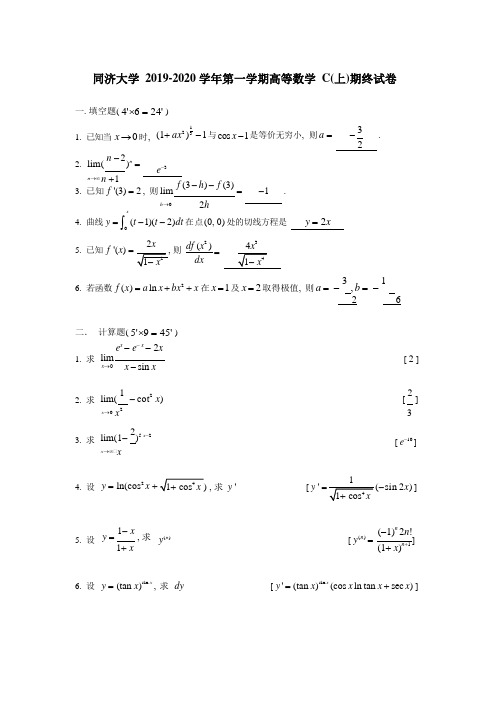
同济大学 2019-2020 学年第一学期高等数学 C(上)期终试卷一. 填空题( 4'⨯6 = 24' )13 1. 已知当 x → 0 时, (1+ ax 2 )3-1与cos x -1是等价无穷小, 则a = - .22. lim( n - 2)n=e -3n →∞ n +13. 已知 f '(3) = 2 , 则lim f (3 - h ) - f (3)= -1 .h →0 2hx4. 曲线 y =⎰(t -1)(t - 2)dt 在点(0, 0) 处的切线方程是y = 2x5. 已知 f '(x ) =2x 则 df (x 2) =dx 36. 若函数 f (x ) = a ln x + bx 2+ x 在 x =1及 x = 2 取得极值, 则a = - 3 , b = - 126二. 计算题( 5'⨯9 = 45' )e x - e - x - 2x1. 求 limx →0 x - sin x[ 2 ]2. 求 lim(1- cot 2 x ) [ 2]x →0x 233. 求 lim(1- 2)5 x -2[ e -10 ]x →∞x4. 设 y = ln(cos 2x +, 求 y ' [ y ' -sin 2x ) ]5. 设y =1- x , 求 1+ xy (n )[ y(n ) =(-1)n 2n !(1+ x )n +1 ]6. 设 y = (tan x )sin x, 求 dy [ y ' = (tan x )sin x(cos x ln tan x + sec x ) ]9. 求,[ 2a 2 - x 2dt = 7. 求a + xdx a - x[ a a rcsinx- ac ]8. 求 ⎰x arctan xdx[ 1x 2arctan x - x + 1arctan x + c ]22 2⎰adx= ⎰πcos t πx +0 sin t + c os t 4三. 解答题( 31' )1. ( 7' )求曲线 xy + 2 ln x = y 4 在点(1, 1) 处的切线与法线方程[ y ' (1, 1) = 1⇒ y = x ;x + y = 2 ]sin t x2. ( 7' )设 f (x ) = lim( )sin t -sin x , 求 f (x ) 的间断点及其类型t →x sin xx[ f (x ) = esin x⇒ x = 0 可去;x = k π (k ≠ 0) 第二类]3. ( 7' )求正数a , 使 axdx1 +∞xdx , 并说出它的几何意义⎰(1+ x 2 )22 ⎰0 (1+ x 2 )2[a xdx = 1(1-1),+∞xdx = 1⇒ a = 1 ]⎰(1+ x 2 )221+ a 2⎰(1+ x 2 )2 24. (10' )设曲线 y = ax 2 (a > 0, x ≥ 0) 与 y = 1- x 2 交于点 A , 过坐标原点O 和点 A 的直线与曲线 y = ax 2围成一个平面图形. 问: a 为何值时, 该图形绕 x 轴旋转一周所得的旋转体体积最大.ax 1ax 2 - 5[ OA : y = , v = π ⎰ 1+a [( )2 - (ax 2 )2 ]dx = π a 2 (1+ a ) 21+ a 0 1+ a15 = a 2 - x 2 ]⇒V ' =0 ⇒a = 4 ⇒V " < 0 ]。
2022年同济大学专业课《金融学》科目期末试卷B(有答案)

2022年同济大学专业课《金融学》科目期末试卷B(有答案)一、选择题1、当一国货币升值时,会引起该国外汇储备的()A.实际价值增加B.实际价值减少C.数量增加D.数量减少2、当价格水平上升,货币需求曲线,利率。
()A.右移:上升B.右移:下降C.左移:下降D.左移:上升3、“劣币驱逐良币”规律发生在()。
A.金银复本位制B.双本位制C.平行本位制D.破行本位制4、以下哪个市场不属于货币市场?()A.国库券市场B.股票市场C.回购市场D.银行间拆借市场5、波浪理论考虑的因素主要包括三个方面,其中最重要的是股价的()。
A.相对位置B.比例C.形态D.时间6、10.如果复利的计息次数增加,则现值()A.不变B.增大C.减小D.不确定7、期权的最大特征是()。
A.风险与收益的对称性B.期权的卖方有执行或放弃执行期权的选择权C.风险与收益的不对称性D.必须每日计算益亏,到期之前会发生现金流动8、在现实生活中,影响货币流通速度的决定性因素是()。
A.商品流通速度B.生产结构、产销衔接的程度C.信用经济发展程度D.人口数量9、10.如果复利的计息次数增加,则现值()A.不变B.增大C.减小D.不确定10、资本流出是指本国资本流到外国,它表示()。
A.外国对本国的负债减少B.本国对外国的负债增加C.外国在本国的资产增加D.外国在本国的资产减少11、其他情况不变,若到期收益率票面利率,则债券将。
()A.高于、溢价出售B.等于、溢价出售C.高于、平价出售D.高于、折价出售12、公司将一张面额为10000元,3个月后到期的商业票据变现,若银行年贴现率为5%,应付金额为()。
A.125B.150C.9875D.980013、目前我国一年期定期存款年利率为2.50%,假设2010年官方公布的CPl为3.80%,则一年期定期存款的实际年利率为()。
A.1.30%B.-1.30%C.-1.25%D.-1.27%14、L公司刚支付了2.25元的股利,并预计股利会以5%每年的速度增长,该公司的风险水平对应的折现率为11%,该公司的股价应与以下哪个数值最接近?()A.20.45元B.21.48元C.37.50元D.39.38元15、下列选项中属于金融创新工具的是()。
同济大学高数试卷大一下学期期末考试
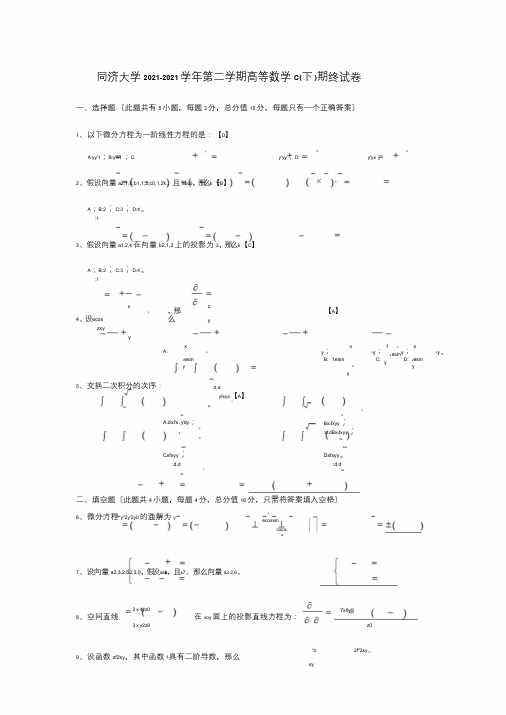
同济大学2021-2021学年第二学期高等数学C(下)期终试卷一、选择题.〔此题共有5小题,每题3分,总分值15分,每题只有一个正确答案〕1、以下微分方程为一阶线性方程的是:【D】y A:yy'1;B:y'e1;C:2y'yy;D:2y'yx。
2、假设向量a2,1,0,b1,1,2,c0,1,2k,且abc0,那么k【B】A;B:2;C:3;D:4。
:13、假设向量a1,2,k在向量b2,1,2上的投影为2,那么k【C】A;B:2;C:3;D:4。
:1xx 4、设ecoszxyy,那么zy【A】A:xx2esinyy ;B:xx1esin2yy ;C:12yxesin y ;D:xx2esinyy 。
5、交换二次积分的次序:22yd,dyfxyx【A】20y4xA:dxfx,ydy;x2x4Bx2fxyy;:d,dBx2fxyy;0x22x Cxfxyy;:d,d20x22x Dxfxyy。
:d,d0x二、填空题〔此题共4小题,每题4分,总分值16分,只需将答案填入空格〕6、微分方程y"2y'2y0的通解为y x ecossincxcx.127、设向量a2,3,2,b2,3,0,假设xax,b,且x7。
那么向量x3,2,6。
8、空间直线2x4yz03x y2z9在xoy面上的投影直线方程为:7x9y9z0。
9、设函数zf2xy,其中函数f具有二阶导数,那么2zxy2f"2xy。
1三、解答题〔此题共有6小题,每题7分,总分值42分,需写出具体解题过程〕10、求微分方程:dyxydx2 1的通解。
[1d ydx2yxyxc]tanln11、一平面过原点及点6,3,2,且与另一平面4xy2z8垂直,求平面方程。
[n6,3,24,1,24,4,62x2y3z0]12、函数zzx,y由zlnz1sinxy所确定,求d z。
[z1cosxydzydxxdyz]13、求函数22fx,y4xyxy的极值点。
创业修炼智慧树知到答案2024年同济大学

创业修炼同济大学智慧树知到答案2024年第一章测试1.创业的追求目标包括()。
A:实现个人价值和理想B:实现公司上市C:以追求经济利益最大化为目的D:实现一些社会的价值,比如人文关怀或者文化传播答案:CD2.创业的构成要素包括()。
A:团队B:商业模式C:机会D:资源答案:ACD3.创业机会包括()。
A:产品B:商业模式C:市场D:技术答案:ACD4.创业机会包括()。
A:可以利用的市场机会B:把资源创造性地结合起来,满足市场及客户需要C:得到一笔闲置的资金D:通过各种创新使之商业化的机会答案:ABD5.创新活动包括()。
A:技术创新B:资源配置创新C:市场创新D:组织创新E:产品创新答案:ABCDE第二章测试1.商业模式是评价优秀企业的一个标准。
()A:错 B:对答案:B2.范蠡贩马的成功因素主要是()。
A:商业机会B:人脉资源C:商业模式D:创始团队答案:C3.共享单车的商业模式主要是()。
A:智能硬件B:移动支付C:运动健康D:共享模式答案:D4.商业模式的本质是利益相关者的交易结构,其六大要素是()。
A:现金流结构B:定位C:盈利模式D:业务系统E:关键资源能力F:企业价值答案:ABCDEF5.商业模式描述了企业如何创造、传递和获取价值的基本原理。
()A:错 B:对答案:B第三章测试1.“大众创业、万众创新”出自李克强总理在2014年夏季达沃斯论坛上的讲话。
()A:对 B:错答案:A2.推进大众创新创业需要()。
A:加强政策集成B:创新服务模式C:坚持市场导向D:强化开放共享答案:ABCD3.推进大众创新创业的重点工作包括()。
A:降低创新创业门槛,支持创新创业公共服务B:构建低成本、便利化、全要素、开放式的众创空间C:完善创业投融资机制D:鼓励科技人员和大学生创业答案:ABCD4.创新创业精神主要表现在()。
A:增长B:对机会的追求C:创新D:风险答案:ABC5.我们要理解企业家、尊重企业家、爱护企业家、支持企业家。
同济大学版高等数学b1教材答案
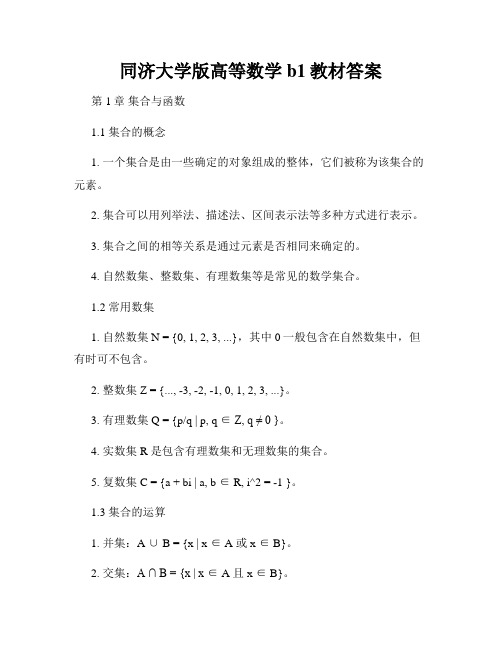
同济大学版高等数学b1教材答案第1章集合与函数1.1 集合的概念1. 一个集合是由一些确定的对象组成的整体,它们被称为该集合的元素。
2. 集合可以用列举法、描述法、区间表示法等多种方式进行表示。
3. 集合之间的相等关系是通过元素是否相同来确定的。
4. 自然数集、整数集、有理数集等是常见的数学集合。
1.2 常用数集1. 自然数集 N = {0, 1, 2, 3, ...},其中0一般包含在自然数集中,但有时可不包含。
2. 整数集 Z = {..., -3, -2, -1, 0, 1, 2, 3, ...}。
3. 有理数集 Q = {p/q | p, q ∈ Z, q ≠ 0 }。
4. 实数集 R 是包含有理数集和无理数集的集合。
5. 复数集 C = {a + bi | a, b ∈ R, i^2 = -1 }。
1.3 集合的运算1. 并集:A ∪ B = {x | x ∈ A 或 x ∈ B}。
2. 交集:A ∩ B = {x | x ∈ A 且 x ∈ B}。
3. 差集:A - B = {x | x ∈ A 且 x ∉ B}。
4. 补集:A' = {x | x 不属于 A},其中 U 为全集。
1.4 函数的概念与性质1. 函数是两个集合之间的一种对应关系,每个自变量在函数中有唯一的对应值。
2. 函数可以用映射图、解析式、函数表等方式来表示。
3. 函数可以分为定义域、值域、单调性、奇偶性等多个性质。
第2章三角函数2.1 弧度制与角度制1. 角度制是通过度数来度量角的大小。
2. 弧度制是通过弧长与半径之比来度量角的大小,常用符号为rad。
3. 180° = π rad,1° = π/180 rad。
2.2 任意角与三角函数1. 任意角是指不限于标准位置的角。
2. 边长比可以用来表示三角函数的值。
2.3 三角函数的定义1. 正弦函数:sinθ = y/r。
2. 余弦函数:cosθ = x/r。
同济大学c++C卷答案

同济大学c++C卷答案同济大学课程考核试卷课号:课名:C++语言考试考查:考查此卷选为:期中考试( )、期终考试(√)、重考( )试卷年级专业学号姓名得分一、选择填空(30分)1)按照标识符的要求,下列符号中不属于标识符组成部分的是(D)。
A、大小写字母B、数字C、下划线D、~ !@ # $ % ^ & *2)若有定义:char c;int x;float y;double z;则表达式x+c-(int)z/y值的类型为(C)。
A、charB、intC、floatD、double3) 有下列定义:char s[10],*p,s1[]={“xyz”};以下语句中正确的是(B)。
A、s =“abcdefgh”;B、p =“abcdefgh”;C、s = s1;D、p=&s; cin >> p;4)以下数组定义中正确的是( C )。
A、int n=5;int a[n];B、int b[3][]={1,2,3};C、int c[3][4]={0};D、int d[][]={2,4,6,8};5)已知int a(5),b(3);当逻辑表达式语句!a&&b++;b||a--||a+b;执行完毕后,a和b的值分别为(D)。
A、4,4B、4,3C、5,4D、5,36) 以下常量中不是字符型常量的是( B )。
A、‘\101’B、"a"C、‘+’D、‘\n’7)对于int *p( );的描述,(B)是正确的。
A、定义一个指向某int型函数的指针变量p。
B、函数p的声明,该函数的返回值是一个指向整型数据的指针值。
C、定义函数p,函数p的返回值为int型数据。
D、定义一个int型指针变量p,指向int型数据。
8)下列变量定义中,不正确的是(D)。
A、int a(0),b=1;B、int a,&b=a;C、int a,*b=&a;D、int a=b=1;9) 有下列定义:int c[10]; int *p;以下执行语句中不能使数组c中元素c[1]的值为1的是(C)。
(完整版)同济大学工程数学线性代数第六版答案(全)
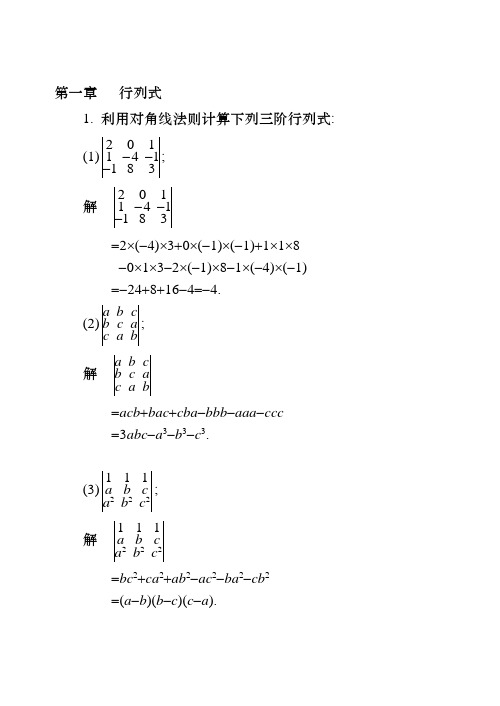
第一章 行列式1. 利用对角线法则计算下列三阶行列式: (1)381141102---;解 381141102---=2⨯(-4)⨯3+0⨯(-1)⨯(-1)+1⨯1⨯8 -0⨯1⨯3-2⨯(-1)⨯8-1⨯(-4)⨯(-1) =-24+8+16-4=-4. (2)b a c a c b cb a ;解 ba c a cb cb a=acb +bac +cba -bbb -aaa -ccc =3abc -a 3-b 3-c 3.(3)222111c b a c b a ;解 222111c b a c b a=bc 2+ca 2+ab 2-ac 2-ba 2-cb 2 =(a -b )(b -c )(c -a ).(4)y x y x x y x y yx y x +++.解 yx y x x y x y yx y x +++=x (x +y )y +yx (x +y )+(x +y )yx -y 3-(x +y )3-x 3 =3xy (x +y )-y 3-3x 2 y -x 3-y 3-x 3 =-2(x 3+y 3).2. 按自然数从小到大为标准次序, 求下列各排列的逆序数:(1)1 2 3 4; 解 逆序数为0 (2)4 1 3 2;解 逆序数为4: 41, 43, 42, 32. (3)3 4 2 1;解 逆序数为5: 3 2, 3 1, 4 2, 4 1, 2 1. (4)2 4 1 3;解 逆序数为3: 2 1, 4 1, 4 3. (5)1 3 ⋅ ⋅ ⋅ (2n -1) 2 4 ⋅ ⋅ ⋅ (2n );解 逆序数为2)1(-n n :3 2 (1个) 5 2, 5 4(2个) 7 2, 7 4, 7 6(3个)⋅⋅⋅⋅⋅⋅(2n-1)2, (2n-1)4, (2n-1)6,⋅⋅⋅, (2n-1)(2n-2) (n-1个)(6)1 3 ⋅⋅⋅(2n-1) (2n) (2n-2) ⋅⋅⋅ 2.解逆序数为n(n-1) :3 2(1个)5 2, 5 4 (2个)⋅⋅⋅⋅⋅⋅(2n-1)2, (2n-1)4, (2n-1)6,⋅⋅⋅, (2n-1)(2n-2) (n-1个)4 2(1个)6 2, 6 4(2个)⋅⋅⋅⋅⋅⋅(2n)2, (2n)4, (2n)6,⋅⋅⋅, (2n)(2n-2) (n-1个)3.写出四阶行列式中含有因子a11a23的项.解含因子a11a23的项的一般形式为(-1)t a11a23a3r a4s,其中rs是2和4构成的排列,这种排列共有两个,即24和42.所以含因子a11a23的项分别是(-1)t a11a23a32a44=(-1)1a11a23a32a44=-a11a23a32a44,(-1)t a11a23a34a42=(-1)2a11a23a34a42=a11a23a34a42.4.计算下列各行列式:(1)71100251020214214; 解 71100251020214214010014231020211021473234-----======c c c c 34)1(143102211014+-⨯---= 143102211014--=01417172001099323211=-++======c c c c .(2)2605232112131412-; 解 2605232112131412-260503212213041224--=====c c 041203212213041224--=====r r 000003212213041214=--=====r r . (3)efcf bf de cd bd aeac ab ---;解 efcf bf de cd bd ae ac ab ---e c b e c b ec b adf ---=abcdef adfbce 4111111111=---=.(4)dc b a 100110011001---. 解d c b a 100110011001---dc b aab ar r 10011001101021---++===== dc a ab 101101)1)(1(12--+--=+01011123-+-++=====cd c ada ab dc ccdad ab +-+--=+111)1)(1(23=abcd +ab +cd +ad +1. 5. 证明:(1)1112222b b a a b ab a +=(a -b )3;证明1112222b b a a b ab a +00122222221213a b a b a a b a ab a c c c c ------=====ab a b a b a ab 22)1(22213-----=+21))((a b a a b a b +--==(a -b )3 . (2)y x z x z y zy x b a bz ay by ax bx az by ax bx az bz ay bx az bz ay by ax )(33+=+++++++++;证明bzay by ax bx az by ax bx az bz ay bxaz bz ay by ax +++++++++bz ay by ax x by ax bx az z bxaz bz ay y b bz ay by ax z by ax bx az y bx az bz ay x a +++++++++++++=bz ay y x by ax x z bxaz z y b y by ax z x bx az y z bz ay x a +++++++=22z y x y x z xz y b y x z x z y z y x a 33+=y x z x z y zy x b y x z x z y z y x a 33+=y x z x z y zy x b a )(33+=.(3)0)3()2()1()3()2()1()3()2()1()3()2()1(2222222222222222=++++++++++++d d d d c c c c b b b b a a a a ; 证明 2222222222222222)3()2()1()3()2()1()3()2()1()3()2()1(++++++++++++d d d d c c c c b b b b a a a a (c 4-c 3, c 3-c 2, c 2-c 1得) 5232125232125232125232122222++++++++++++=d d d d c c c c b b b b a a a a (c 4-c 3, c 3-c 2得)022122212221222122222=++++=d d c c b b a a . (4)444422221111d c b a d c b a d c b a =(a -b )(a -c )(a -d )(b -c )(b -d )(c -d )(a +b +c +d ); 证明 444422221111d c b a d c b a d c b a )()()(0)()()(001111222222222a d d a c c a b b a d d a c c a b b ad a c a b ---------=)()()(111))()((222a d d a c c a b b d c b a d a c a b +++---=))(())((00111))()((a b d b d d a b c b c c b d b c a d a c a b ++-++------=)()(11))()()()((a b d d a b c c b d b c a d a c a b ++++-----==(a -b )(a -c )(a -d )(b -c )(b -d )(c -d )(a +b +c +d ).(5)1221 1 000 00 1000 01a x a a a a x x xn n n +⋅⋅⋅-⋅⋅⋅⋅⋅⋅⋅⋅⋅⋅⋅⋅⋅⋅⋅⋅⋅⋅⋅⋅⋅-⋅⋅⋅--- =x n +a 1x n -1+ ⋅ ⋅ ⋅ +a n -1x +a n .证明 用数学归纳法证明.当n =2时, 2121221a x a x a x a x D ++=+-=, 命题成立. 假设对于(n -1)阶行列式命题成立, 即 D n -1=x n -1+a 1 x n -2+ ⋅ ⋅ ⋅ +a n -2x +a n -1, 则D n 按第一列展开, 有11100 100 01)1(11-⋅⋅⋅⋅⋅⋅⋅⋅⋅⋅⋅⋅⋅⋅⋅⋅⋅⋅⋅⋅⋅-⋅⋅⋅--+=+-x x a xD D n n n n =xD n -1+a n =x n +a 1x n -1+ ⋅ ⋅ ⋅ +a n -1x +a n . 因此, 对于n 阶行列式命题成立.6. 设n 阶行列式D =det(a ij ), 把D 上下翻转、或逆时针旋转90︒、或依副对角线翻转, 依次得n nn n a a a a D 11111 ⋅⋅⋅⋅⋅⋅⋅⋅⋅⋅⋅⋅⋅⋅⋅=, 11112 n nn n a a a a D ⋅⋅⋅⋅⋅⋅⋅⋅⋅⋅⋅⋅⋅⋅⋅= , 11113 a a a a D n nnn ⋅⋅⋅⋅⋅⋅⋅⋅⋅⋅⋅⋅⋅⋅⋅=,证明D D D n n 2)1(21)1(--==, D 3=D .证明 因为D =det(a ij ), 所以 nnn n n n nnnn a a a a a a a a a a D 2211111111111 )1( ⋅⋅⋅⋅⋅⋅⋅⋅⋅⋅⋅⋅⋅⋅⋅⋅⋅⋅-=⋅⋅⋅⋅⋅⋅⋅⋅⋅⋅⋅⋅⋅⋅⋅=-⋅⋅⋅=⋅⋅⋅⋅⋅⋅⋅⋅⋅⋅⋅⋅⋅⋅⋅⋅⋅⋅⋅⋅⋅--=-- )1()1(331122111121nnn n nn n n a a a a a a a a D D n n n n 2)1()1()2( 21)1()1(--+-+⋅⋅⋅++-=-=.同理可证 nnn n n n a a a a D ⋅⋅⋅⋅⋅⋅⋅⋅⋅⋅⋅⋅⋅⋅⋅-=- )1(11112)1(2D D n n T n n 2)1(2)1()1()1(---=-=. D D D D D n n n n n n n n =-=--=-=----)1(2)1(2)1(22)1(3)1()1()1()1(.7. 计算下列各行列式(D k 为k 阶行列式): (1)aa D n 11⋅⋅⋅=, 其中对角线上元素都是a , 未写出的元素都是0; 解 aa a a a D n 010 000 00 000 0010 00⋅⋅⋅⋅⋅⋅⋅⋅⋅⋅⋅⋅⋅⋅⋅⋅⋅⋅⋅⋅⋅⋅⋅⋅⋅⋅⋅⋅⋅⋅⋅⋅⋅=(按第n 行展开) )1()1(10 000 00 000 0010 000)1(-⨯-+⋅⋅⋅⋅⋅⋅⋅⋅⋅⋅⋅⋅⋅⋅⋅⋅⋅⋅⋅⋅⋅⋅⋅⋅⋅⋅⋅⋅⋅⋅-=n n n aa a )1()1(2 )1(-⨯-⋅⋅⋅⋅-+n n n a a an n n nn a a a+⋅⋅⋅-⋅-=--+)2)(2(1)1()1(=a n -a n -2=a n -2(a 2-1).(2)xa a a x a a a xD n ⋅⋅⋅⋅⋅⋅⋅⋅⋅⋅⋅⋅⋅⋅⋅⋅⋅⋅⋅⋅⋅= ; 解 将第一行乘(-1)分别加到其余各行, 得 ax x a ax x a a x x a a a a x D n --⋅⋅⋅⋅⋅⋅⋅⋅⋅⋅⋅⋅⋅⋅⋅⋅⋅⋅--⋅⋅⋅--⋅⋅⋅=000 0 00 0, 再将各列都加到第一列上, 得ax ax a x aaa a n x D n -⋅⋅⋅⋅⋅⋅⋅⋅⋅⋅⋅⋅⋅⋅⋅⋅⋅⋅-⋅⋅⋅-⋅⋅⋅-+=0000 0 0000 )1(=[x +(n -1)a ](x -a )n -1. (3)111 1 )( )1()( )1(1111⋅⋅⋅-⋅⋅⋅⋅⋅⋅⋅⋅⋅-⋅⋅⋅⋅⋅⋅-⋅⋅⋅--⋅⋅⋅-=---+n a a a n a a a n a a a D n n n n nn n ; 解 根据第6题结果, 有nn n n n n n n n n a a a n a a a n a a aD )( )1()( )1( 11 11)1(1112)1(1-⋅⋅⋅--⋅⋅⋅⋅⋅⋅⋅⋅⋅-⋅⋅⋅⋅⋅⋅-⋅⋅⋅-⋅⋅⋅-=---++此行列式为范德蒙德行列式.∏≥>≥++++--+--=112)1(1)]1()1[()1(j i n n n n j a i a D∏≥>≥++---=112)1()]([)1(j i n n n j i∏≥>≥++⋅⋅⋅+-++-⋅-⋅-=1121)1(2)1()()1()1(j i n n n n n j i∏≥>≥+-=11)(j i n j i .(4)n nnnn d c d c b a b a D ⋅⋅⋅⋅⋅⋅⋅⋅⋅⋅⋅⋅=11112; 解nnnnn d c d c b a b a D ⋅⋅⋅⋅⋅⋅⋅⋅⋅⋅⋅⋅=11112(按第1行展开) nn n n n nd d c d c b a b a a 00011111111----⋅⋅⋅⋅⋅⋅⋅⋅⋅⋅⋅⋅=0)1(1111111112c d c d c b a b a b nn n n n nn ----+⋅⋅⋅⋅⋅⋅⋅⋅⋅⋅⋅⋅-+. 再按最后一行展开得递推公式D 2n =a n d n D 2n -2-b n c n D 2n -2, 即D 2n =(a n d n -b n c n )D 2n -2. 于是 ∏=-=ni i i i i n D c b d a D 222)(.而 111111112c b d a d c b a D -==, 所以 ∏=-=ni i i i i n c b d a D 12)(.(5) D =det(a ij ), 其中a ij =|i -j |; 解 a ij =|i -j |, 043214 01233 10122 21011 3210)det(⋅⋅⋅----⋅⋅⋅⋅⋅⋅⋅⋅⋅⋅⋅⋅⋅⋅⋅⋅⋅⋅-⋅⋅⋅-⋅⋅⋅-⋅⋅⋅-⋅⋅⋅==n n n n n n n n a D ij n 04321 1 11111 11111 11111 1111 2132⋅⋅⋅----⋅⋅⋅⋅⋅⋅⋅⋅⋅⋅⋅⋅⋅⋅⋅⋅⋅⋅⋅⋅⋅----⋅⋅⋅---⋅⋅⋅--⋅⋅⋅--⋅⋅⋅-=====n n n n r r r r15242321 0 22210 02210 00210 0001 1213-⋅⋅⋅----⋅⋅⋅⋅⋅⋅⋅⋅⋅⋅⋅⋅⋅⋅⋅⋅⋅⋅⋅⋅⋅----⋅⋅⋅---⋅⋅⋅--⋅⋅⋅-+⋅⋅⋅+=====n n n n n c c c c =(-1)n -1(n -1)2n -2. (6)nn a a a D +⋅⋅⋅⋅⋅⋅⋅⋅⋅⋅⋅⋅⋅⋅⋅⋅⋅⋅+⋅⋅⋅+=1 11 1 1111121, 其中a 1a 2 ⋅ ⋅ ⋅ a n≠0.解nn a a a D +⋅⋅⋅⋅⋅⋅⋅⋅⋅⋅⋅⋅⋅⋅⋅⋅⋅⋅+⋅⋅⋅+=1 11 1 1111121 nn n n a a a a a a a a a c c c c +-⋅⋅⋅-⋅⋅⋅⋅⋅⋅⋅⋅⋅⋅⋅⋅⋅⋅⋅⋅⋅⋅⋅⋅⋅⋅⋅⋅⋅⋅⋅-⋅⋅⋅-⋅⋅⋅-⋅⋅⋅-=====--10 0001 000 100 0100 0100 0011332212132 1111312112111011 000 00 11000 01100 001 ------+-⋅⋅⋅-⋅⋅⋅⋅⋅⋅⋅⋅⋅⋅⋅⋅⋅⋅⋅⋅⋅⋅⋅⋅⋅⋅⋅⋅⋅⋅⋅-⋅⋅⋅-⋅⋅⋅⋅⋅⋅=nn n a a a a a a a a∑=------+⋅⋅⋅⋅⋅⋅⋅⋅⋅⋅⋅⋅⋅⋅⋅⋅⋅⋅⋅⋅⋅⋅⋅⋅⋅⋅⋅⋅⋅⋅⋅⋅⋅⋅⋅⋅⋅⋅⋅=n i i n n a a a a a a a a 1111131******** 00010 000 00 10000 01000 001)11)((121∑=+=ni i n a a a a .8. 用克莱姆法则解下列方程组:(1)⎪⎩⎪⎨⎧=+++-=----=+-+=+++01123253224254321432143214321x x x x x x x x x x x x x x x x ;解 因为14211213513241211111-=----=D , 142112105132412211151-=------=D , 284112035122412111512-=-----=D , 426110135232422115113-=----=D , 14202132132212151114=-----=D , 所以 111==DD x , 222==D D x , 333==D D x , 144-==D D x .(2)⎪⎪⎩⎪⎪⎨⎧=+=++=++=++=+150650650651655454343232121x x x x x x x x x x x x x .解 因为 665510006510006510065100065==D , 150751001651000651000650000611==D , 114551010651000650000601000152-==D , 70351100650000601000051001653==D , 395510601000051000651010654-==D , 2121105100065100651100655==D , 所以66515071=x , 66511452-=x , 6657033=x , 6653954-=x , 6652124=x .9. 问λ, μ取何值时, 齐次线性方程组⎪⎩⎪⎨⎧=++=++=++0200321321321x x x x x x x x x μμλ有非零解?解 系数行列式为μλμμμλ-==1211111D .令D =0, 得 μ=0或λ=1.于是, 当μ=0或λ=1时该齐次线性方程组有非零解.10. 问λ取何值时, 齐次线性方程组⎪⎩⎪⎨⎧=-++=+-+=+--0)1(0)3(2042)1(321321321x x x x x x x x x λλλ有非零解?解 系数行列式为λλλλλλλ--+--=----=101112431111132421D=(1-λ)3+(λ-3)-4(1-λ)-2(1-λ)(-3-λ) =(1-λ)3+2(1-λ)2+λ-3. 令D =0, 得λ=0, λ=2或λ=3.于是, 当λ=0, λ=2或λ=3时, 该齐次线性方程组有非零解.第二章 矩阵及其运算1. 已知线性变换:⎪⎩⎪⎨⎧++=++=++=3213321232113235322y y y x y y y x y y y x , 求从变量x 1, x 2, x 3到变量y 1, y 2, y 3的线性变换. 解 由已知:⎪⎪⎭⎫⎝⎛⎪⎪⎭⎫ ⎝⎛=⎪⎪⎭⎫ ⎝⎛221321323513122y y y x x x ,故 ⎪⎪⎭⎫ ⎝⎛⎪⎪⎭⎫ ⎝⎛=⎪⎪⎭⎫ ⎝⎛-3211221323513122x x x y y y ⎪⎪⎭⎫⎝⎛⎪⎪⎭⎫ ⎝⎛----=321423736947y y y ,⎪⎩⎪⎨⎧-+=-+=+--=321332123211423736947x x x y x x x y x x x y .2. 已知两个线性变换⎪⎩⎪⎨⎧++=++-=+=32133212311542322y y y x y y y x y y x ,⎪⎩⎪⎨⎧+-=+=+-=323312211323z z y z z y z z y , 求从z 1, z 2, z 3到x 1, x 2, x 3的线性变换.解 由已知⎪⎪⎭⎫ ⎝⎛⎪⎪⎭⎫ ⎝⎛-=⎪⎪⎭⎫ ⎝⎛221321514232102y y y x x x ⎪⎪⎭⎫⎝⎛⎪⎪⎭⎫ ⎝⎛--⎪⎪⎭⎫ ⎝⎛-=321310102013514232102z z z⎪⎪⎭⎫ ⎝⎛⎪⎪⎭⎫ ⎝⎛----=321161109412316z z z ,所以有⎪⎩⎪⎨⎧+--=+-=++-=3213321232111610941236z z z x z z z x z z z x .3. 设⎪⎪⎭⎫ ⎝⎛--=111111111A , ⎪⎪⎭⎫⎝⎛--=150421321B , 求3AB -2A 及A T B .解 ⎪⎪⎭⎫⎝⎛---⎪⎪⎭⎫ ⎝⎛--⎪⎪⎭⎫ ⎝⎛--=-1111111112150421321111111111323A AB⎪⎪⎭⎫⎝⎛----=⎪⎪⎭⎫ ⎝⎛---⎪⎪⎭⎫ ⎝⎛-=2294201722213211111111120926508503,⎪⎪⎭⎫⎝⎛-=⎪⎪⎭⎫ ⎝⎛--⎪⎪⎭⎫ ⎝⎛--=092650850150421321111111111B A T.4. 计算下列乘积:(1)⎪⎪⎭⎫⎝⎛⎪⎪⎭⎫ ⎝⎛-127075321134;解 ⎪⎪⎭⎫ ⎝⎛⎪⎪⎭⎫ ⎝⎛-127075321134⎪⎪⎭⎫ ⎝⎛⨯+⨯+⨯⨯+⨯-+⨯⨯+⨯+⨯=102775132)2(71112374⎪⎪⎭⎫⎝⎛=49635.(2)⎪⎪⎭⎫⎝⎛123)321(;解 ⎪⎪⎭⎫⎝⎛123)321(=(1⨯3+2⨯2+3⨯1)=(10).(3))21(312-⎪⎪⎭⎫⎝⎛;解 )21(312-⎪⎪⎭⎫⎝⎛⎪⎪⎭⎫ ⎝⎛⨯-⨯⨯-⨯⨯-⨯=23)1(321)1(122)1(2⎪⎪⎭⎫⎝⎛---=632142. (4)⎪⎪⎪⎭⎫ ⎝⎛---⎪⎭⎫ ⎝⎛-20413121013143110412 ; 解 ⎪⎪⎪⎭⎫⎝⎛---⎪⎭⎫ ⎝⎛-20413121013143110412⎪⎭⎫ ⎝⎛---=6520876.(5)⎪⎪⎭⎫⎝⎛⎪⎪⎭⎫ ⎝⎛321332313232212131211321)(x x x a a a a a a a a a x x x ;解⎪⎪⎭⎫⎝⎛⎪⎪⎭⎫ ⎝⎛321332313232212131211321)(x x x a a a a a a a a a x x x=(a 11x 1+a 12x 2+a 13x 3 a 12x 1+a 22x 2+a 23x 3 a 13x 1+a 23x 2+a 33x 3)⎪⎪⎭⎫⎝⎛321x x x322331132112233322222111222x x a x x a x x a x a x a x a +++++=.5. 设⎪⎭⎫ ⎝⎛=3121A , ⎪⎭⎫ ⎝⎛=2101B , 问: (1)AB =BA 吗? 解 AB ≠BA .因为⎪⎭⎫ ⎝⎛=6443AB , ⎪⎭⎫ ⎝⎛=8321BA , 所以AB ≠BA .(2)(A +B )2=A 2+2AB +B 2吗? 解 (A +B )2≠A 2+2AB +B 2.因为⎪⎭⎫ ⎝⎛=+5222B A , ⎪⎭⎫ ⎝⎛⎪⎭⎫ ⎝⎛=+52225222)(2B A ⎪⎭⎫ ⎝⎛=2914148,但 ⎪⎭⎫ ⎝⎛+⎪⎭⎫ ⎝⎛+⎪⎭⎫ ⎝⎛=++43011288611483222B AB A ⎪⎭⎫ ⎝⎛=27151610, 所以(A +B )2≠A 2+2AB +B 2. (3)(A +B )(A -B )=A 2-B 2吗? 解 (A +B )(A -B )≠A 2-B 2.因为⎪⎭⎫ ⎝⎛=+5222B A , ⎪⎭⎫ ⎝⎛=-1020B A ,⎪⎭⎫ ⎝⎛=⎪⎭⎫ ⎝⎛⎪⎭⎫ ⎝⎛=-+906010205222))((B A B A ,而 ⎪⎭⎫ ⎝⎛=⎪⎭⎫ ⎝⎛-⎪⎭⎫ ⎝⎛=-718243011148322B A ,故(A +B )(A -B )≠A 2-B 2.6. 举反列说明下列命题是错误的:(1)若A 2=0, 则A =0;解 取⎪⎭⎫ ⎝⎛=0010A , 则A 2=0, 但A ≠0. (2)若A 2=A , 则A =0或A =E ; 解 取⎪⎭⎫ ⎝⎛=0011A , 则A 2=A , 但A ≠0且A ≠E . (3)若AX =AY , 且A ≠0, 则X =Y .解 取 ⎪⎭⎫ ⎝⎛=0001A , ⎪⎭⎫ ⎝⎛-=1111X , ⎪⎭⎫ ⎝⎛=1011Y , 则AX =AY , 且A ≠0, 但X ≠Y .7. 设⎪⎭⎫ ⎝⎛=101λA , 求A 2, A 3, ⋅ ⋅ ⋅, A k . 解 ⎪⎭⎫ ⎝⎛=⎪⎭⎫ ⎝⎛⎪⎭⎫ ⎝⎛=12011011012λλλA , ⎪⎭⎫ ⎝⎛=⎪⎭⎫ ⎝⎛⎪⎭⎫ ⎝⎛==1301101120123λλλA A A , ⋅ ⋅ ⋅ ⋅ ⋅ ⋅,⎪⎭⎫ ⎝⎛=101λk A k . 8. 设⎪⎪⎭⎫ ⎝⎛=λλλ001001A , 求A k . 解 首先观察⎪⎪⎭⎫ ⎝⎛⎪⎪⎭⎫ ⎝⎛=λλλλλλ0010010010012A ⎪⎪⎭⎫ ⎝⎛=222002012λλλλλ,⎪⎪⎭⎫ ⎝⎛=⋅=3232323003033λλλλλλA A A , ⎪⎪⎭⎫ ⎝⎛=⋅=43423434004064λλλλλλA A A , ⎪⎪⎭⎫ ⎝⎛=⋅=545345450050105λλλλλλA A A , ⋅ ⋅ ⋅ ⋅ ⋅ ⋅,⎝⎛=k A k k k k k k k k k k λλλλλλ0002)1(121----⎪⎪⎪⎭⎫ . 用数学归纳法证明:当k =2时, 显然成立.假设k 时成立,则k +1时, ⎪⎪⎭⎫ ⎝⎛⎪⎪⎪⎪⎭⎫ ⎝⎛-=⋅=---+λλλλλλλλλ0010010002)1(1211k k k k k k k k k k k k A A A ⎪⎪⎪⎪⎭⎫ ⎝⎛+++=+-+--+11111100)1(02)1()1(k k k k k k k k k k λλλλλλ, 由数学归纳法原理知:⎪⎪⎪⎪⎭⎫ ⎝⎛-=---k k k k k k k k k k k A λλλλλλ0002)1(121. 9. 设A , B 为n 阶矩阵,且A 为对称矩阵,证明B T AB 也是对称矩阵.证明 因为A T =A , 所以(B T AB )T =B T (B T A )T =B T A T B =B T AB ,从而B T AB 是对称矩阵.10. 设A , B 都是n 阶对称矩阵,证明AB 是对称矩阵的充分必要条件是AB =BA .证明 充分性: 因为A T =A , B T =B , 且AB =BA , 所以 (AB )T =(BA )T =A T B T =AB ,即AB 是对称矩阵.必要性: 因为A T =A , B T =B , 且(AB )T =AB , 所以AB =(AB )T =B T A T =BA .11. 求下列矩阵的逆矩阵:(1)⎪⎭⎫ ⎝⎛5221; 解 ⎪⎭⎫ ⎝⎛=5221A . |A |=1, 故A -1存在. 因为 ⎪⎭⎫ ⎝⎛--=⎪⎭⎫ ⎝⎛=1225*22122111A A A A A ,故 *||11A A A =-⎪⎭⎫ ⎝⎛--=1225. (2)⎪⎭⎫ ⎝⎛-θθθθcos sin sin cos ; 解 ⎪⎭⎫ ⎝⎛-=θθθθcos sin sin cos A . |A |=1≠0, 故A -1存在. 因为 ⎪⎭⎫ ⎝⎛-=⎪⎭⎫ ⎝⎛=θθθθcos sin sin cos *22122111A A A A A , 所以 *||11A A A =-⎪⎭⎫ ⎝⎛-=θθθθcos sin sin cos . (3)⎪⎪⎭⎫ ⎝⎛---145243121; 解 ⎪⎪⎭⎫ ⎝⎛---=145243121A . |A |=2≠0, 故A -1存在. 因为 ⎪⎪⎭⎫ ⎝⎛-----=⎪⎪⎭⎫ ⎝⎛=214321613024*332313322212312111A A A A A A A A A A , 所以 *||11A A A =-⎪⎪⎪⎭⎫ ⎝⎛-----=1716213213012. (4)⎪⎪⎪⎭⎫ ⎝⎛n a a a 0021(a 1a 2⋅ ⋅ ⋅a n ≠0) .解 ⎪⎪⎪⎭⎫ ⎝⎛=n a a a A 0021, 由对角矩阵的性质知 ⎪⎪⎪⎪⎪⎪⎭⎫ ⎝⎛=-n a a a A 10011211 . 12. 解下列矩阵方程:(1)⎪⎭⎫ ⎝⎛-=⎪⎭⎫ ⎝⎛12643152X ; 解 ⎪⎭⎫ ⎝⎛-⎪⎭⎫ ⎝⎛=-126431521X ⎪⎭⎫ ⎝⎛-⎪⎭⎫ ⎝⎛--=12642153⎪⎭⎫ ⎝⎛-=80232. (2)⎪⎭⎫ ⎝⎛-=⎪⎪⎭⎫ ⎝⎛--234311*********X ; 解 1111012112234311-⎪⎪⎭⎫ ⎝⎛--⎪⎭⎫ ⎝⎛-=X ⎪⎪⎭⎫ ⎝⎛---⎪⎭⎫ ⎝⎛-=03323210123431131 ⎪⎪⎭⎫ ⎝⎛---=32538122. (3)⎪⎭⎫ ⎝⎛-=⎪⎭⎫ ⎝⎛-⎪⎭⎫ ⎝⎛-101311022141X ;解 11110210132141--⎪⎭⎫ ⎝⎛-⎪⎭⎫ ⎝⎛-⎪⎭⎫ ⎝⎛-=X ⎪⎭⎫ ⎝⎛⎪⎭⎫ ⎝⎛-⎪⎭⎫ ⎝⎛-=210110131142121 ⎪⎭⎫ ⎝⎛⎪⎭⎫ ⎝⎛=21010366121⎪⎪⎭⎫ ⎝⎛=04111. (4)⎪⎪⎭⎫ ⎝⎛---=⎪⎪⎭⎫ ⎝⎛⎪⎪⎭⎫ ⎝⎛021102341010100001100001010X . 解 11010100001021102341100001010--⎪⎪⎭⎫ ⎝⎛⎪⎪⎭⎫ ⎝⎛---⎪⎪⎭⎫ ⎝⎛=X ⎪⎪⎭⎫ ⎝⎛⎪⎪⎭⎫ ⎝⎛---⎪⎪⎭⎫ ⎝⎛=010100001021102341100001010⎪⎪⎭⎫ ⎝⎛---=201431012. 13. 利用逆矩阵解下列线性方程组:(1)⎪⎩⎪⎨⎧=++=++=++3532522132321321321x x x x x x x x x ; 解 方程组可表示为⎪⎪⎭⎫ ⎝⎛=⎪⎪⎭⎫ ⎝⎛⎪⎪⎭⎫ ⎝⎛321153522321321x x x , 故 ⎪⎪⎭⎫ ⎝⎛=⎪⎪⎭⎫ ⎝⎛⎪⎪⎭⎫ ⎝⎛=⎪⎪⎭⎫ ⎝⎛-0013211535223211321x x x ,从而有 ⎪⎩⎪⎨⎧===001321x x x . (2)⎪⎩⎪⎨⎧=-+=--=--05231322321321321x x x x x x x x x . 解 方程组可表示为⎪⎪⎭⎫ ⎝⎛=⎪⎪⎭⎫ ⎝⎛⎪⎪⎭⎫ ⎝⎛-----012523312111321x x x , 故 ⎪⎪⎭⎫ ⎝⎛=⎪⎪⎭⎫ ⎝⎛⎪⎪⎭⎫ ⎝⎛-----=⎪⎪⎭⎫ ⎝⎛-3050125233121111321x x x , 故有 ⎪⎩⎪⎨⎧===305321x x x . 14. 设A k =O (k 为正整数), 证明(E -A )-1=E +A +A 2+⋅ ⋅ ⋅+A k -1. 证明 因为A k =O , 所以E -A k =E . 又因为E -A k =(E -A )(E +A +A 2+⋅ ⋅ ⋅+A k -1),所以 (E -A )(E +A +A 2+⋅ ⋅ ⋅+A k -1)=E ,由定理2推论知(E -A )可逆, 且(E -A )-1=E +A +A 2+⋅ ⋅ ⋅+A k -1.证明 一方面, 有E =(E -A )-1(E -A ).另一方面, 由A k =O , 有E =(E -A )+(A -A 2)+A 2-⋅ ⋅ ⋅-A k -1+(A k -1-A k )=(E +A +A 2+⋅ ⋅ ⋅+A k -1)(E -A ),故 (E -A )-1(E -A )=(E +A +A 2+⋅ ⋅ ⋅+A k -1)(E -A ),两端同时右乘(E -A )-1, 就有(E -A )-1(E -A )=E +A +A 2+⋅ ⋅ ⋅+A k -1.15. 设方阵A 满足A 2-A -2E =O , 证明A 及A +2E 都可逆, 并求A -1及(A +2E )-1.证明 由A 2-A -2E =O 得A 2-A =2E , 即A (A -E )=2E ,或 E E A A =-⋅)(21, 由定理2推论知A 可逆, 且)(211E A A -=-. 由A 2-A -2E =O 得A 2-A -6E =-4E , 即(A +2E )(A -3E )=-4E ,或 E A E E A =-⋅+)3(41)2( 由定理2推论知(A +2E )可逆, 且)3(41)2(1A E E A -=+-.证明 由A 2-A -2E =O 得A 2-A =2E , 两端同时取行列式得 |A 2-A |=2,即 |A ||A -E |=2,故 |A |≠0,所以A 可逆, 而A +2E =A 2, |A +2E |=|A 2|=|A |2≠0, 故A +2E 也可逆. 由 A 2-A -2E =O ⇒A (A -E )=2E⇒A -1A (A -E )=2A -1E ⇒)(211E A A -=-, 又由 A 2-A -2E =O ⇒(A +2E )A -3(A +2E )=-4E⇒ (A +2E )(A -3E )=-4 E ,所以 (A +2E )-1(A +2E )(A -3E )=-4(A +2 E )-1,)3(41)2(1A E E A -=+-. 16. 设A 为3阶矩阵, 21||=A , 求|(2A )-1-5A *|. 解 因为*||11A A A =-, 所以 |||521||*5)2(|111----=-A A A A A |2521|11---=A A =|-2A -1|=(-2)3|A -1|=-8|A |-1=-8⨯2=-16. 17. 设矩阵A 可逆, 证明其伴随阵A *也可逆, 且(A *)-1=(A -1)*.证明 由*||11A A A =-, 得A *=|A |A -1, 所以当A 可逆时, 有 |A *|=|A |n |A -1|=|A |n -1≠0,从而A *也可逆.因为A *=|A |A -1, 所以(A *)-1=|A |-1A . 又*)(||)*(||1111---==A A A A A , 所以(A *)-1=|A |-1A =|A |-1|A |(A -1)*=(A -1)*.18. 设n 阶矩阵A 的伴随矩阵为A *, 证明:(1)若|A |=0, 则|A *|=0;(2)|A *|=|A |n -1.证明(1)用反证法证明. 假设|A *|≠0, 则有A *(A *)-1=E , 由此得 A =A A *(A *)-1=|A |E (A *)-1=O ,所以A *=O , 这与|A *|≠0矛盾,故当|A |=0时, 有|A *|=0.(2)由于*||11A A A =-, 则AA *=|A |E , 取行列式得到 |A ||A *|=|A |n .若|A |≠0, 则|A *|=|A |n -1;若|A |=0, 由(1)知|A *|=0, 此时命题也成立.因此|A *|=|A |n -1.19. 设⎪⎪⎭⎫ ⎝⎛-=321011330A , AB =A +2B , 求B . 解 由AB =A +2E 可得(A -2E )B =A , 故⎪⎪⎭⎫ ⎝⎛-⎪⎪⎭⎫ ⎝⎛---=-=--321011330121011332)2(11A E A B ⎪⎪⎭⎫ ⎝⎛-=011321330. 20. 设⎪⎪⎭⎫ ⎝⎛=101020101A , 且AB +E =A 2+B , 求B .解 由AB +E =A 2+B 得 (A -E )B =A 2-E , 即 (A -E )B =(A -E )(A +E ).因为01001010100||≠-==-E A , 所以(A -E )可逆, 从而⎪⎪⎭⎫⎝⎛=+=201030102E A B .21. 设A =diag(1, -2, 1), A *BA =2BA -8E , 求B . 解 由A *BA =2BA -8E 得 (A *-2E )BA =-8E , B =-8(A *-2E )-1A -1 =-8[A (A *-2E )]-1 =-8(AA *-2A )-1 =-8(|A |E -2A )-1 =-8(-2E -2A )-1 =4(E +A )-1=4[diag(2, -1, 2)]-1)21 ,1 ,21(diag 4-==2diag(1, -2, 1).22. 已知矩阵A 的伴随阵⎪⎪⎪⎭⎫⎝⎛-=8030010100100001*A , 且ABA -1=BA -1+3E , 求B .解 由|A *|=|A |3=8, 得|A |=2. 由ABA -1=BA -1+3E 得 AB =B +3A ,B =3(A -E )-1A =3[A (E -A -1)]-1A 11*)2(6*)21(3---=-=A E A E⎪⎪⎪⎭⎫ ⎝⎛-=⎪⎪⎪⎭⎫⎝⎛--=-1030060600600006603001010010000161. 23. 设P -1AP =Λ, 其中⎪⎭⎫ ⎝⎛--=1141P , ⎪⎭⎫ ⎝⎛-=Λ2001, 求A 11. 解 由P -1AP =Λ, 得A =P ΛP -1, 所以A 11= A =P Λ11P -1.|P |=3, ⎪⎭⎫ ⎝⎛-=1141*P , ⎪⎭⎫ ⎝⎛--=-1141311P ,而 ⎪⎭⎫ ⎝⎛-=⎪⎭⎫ ⎝⎛-=Λ11111120 012001,故 ⎪⎪⎪⎭⎫⎝⎛--⎪⎭⎫ ⎝⎛-⎪⎭⎫ ⎝⎛--=31313431200111411111A ⎪⎭⎫ ⎝⎛--=68468327322731. 24. 设AP =P Λ, 其中⎪⎪⎭⎫⎝⎛--=111201111P , ⎪⎪⎭⎫ ⎝⎛-=Λ511,求ϕ(A )=A 8(5E -6A +A 2). 解 ϕ(Λ)=Λ8(5E -6Λ+Λ2)=diag(1,1,58)[diag(5,5,5)-diag(-6,6,30)+diag(1,1,25)]=diag(1,1,58)diag(12,0,0)=12diag(1,0,0). ϕ(A )=P ϕ(Λ)P -1*)(||1P P P Λ=ϕ⎪⎪⎭⎫⎝⎛------⎪⎪⎭⎫ ⎝⎛⎪⎪⎭⎫ ⎝⎛---=1213032220000000011112011112⎪⎪⎭⎫⎝⎛=1111111114.25. 设矩阵A 、B 及A +B 都可逆, 证明A -1+B -1也可逆, 并求其逆阵. 证明 因为A -1(A +B )B -1=B -1+A -1=A -1+B -1,而A -1(A +B )B -1是三个可逆矩阵的乘积, 所以A -1(A +B )B -1可逆, 即A -1+B -1可逆.(A -1+B -1)-1=[A -1(A +B )B -1]-1=B (A +B )-1A .26. 计算⎪⎪⎪⎭⎫ ⎝⎛---⎪⎪⎪⎭⎫⎝⎛30003200121013013000120010100121. 解 设⎪⎭⎫ ⎝⎛=10211A , ⎪⎭⎫ ⎝⎛=30122A , ⎪⎭⎫ ⎝⎛-=12131B , ⎪⎭⎫ ⎝⎛--=30322B ,则 ⎪⎭⎫ ⎝⎛⎪⎭⎫ ⎝⎛2121B O B E A O E A ⎪⎭⎫⎝⎛+=222111B A O B B A A ,而 ⎪⎭⎫ ⎝⎛-=⎪⎭⎫ ⎝⎛--+⎪⎭⎫ ⎝⎛-⎪⎭⎫ ⎝⎛=+4225303212131021211B B A ,⎪⎭⎫ ⎝⎛--=⎪⎭⎫ ⎝⎛--⎪⎭⎫ ⎝⎛=90343032301222B A , 所以 ⎪⎭⎫ ⎝⎛⎪⎭⎫ ⎝⎛2121B O B E A O E A ⎪⎭⎫ ⎝⎛+=222111B A O B B A A ⎪⎪⎪⎭⎫ ⎝⎛---=9000340042102521, 即 ⎪⎪⎪⎭⎫ ⎝⎛---⎪⎪⎪⎭⎫⎝⎛30003200121013013000120010100121⎪⎪⎪⎭⎫ ⎝⎛---=9000340042102521. 27. 取⎪⎭⎫ ⎝⎛==-==1001D C B A , 验证|||||||| D C B A D C B A ≠.解 4100120021010*********0021010010110100101==--=--=D C B A , 而 01111|||||||| ==D C B A ,故 |||||||| D C B A D C B A ≠.28. 设⎪⎪⎪⎭⎫ ⎝⎛-=22023443O O A , 求|A 8|及A 4. 解 令⎪⎭⎫ ⎝⎛-=34431A , ⎪⎭⎫ ⎝⎛=22022A ,则 ⎪⎭⎫⎝⎛=21A O O A A ,故 8218⎪⎭⎫ ⎝⎛=A O O A A ⎪⎭⎫ ⎝⎛=8281A O O A ,1682818281810||||||||||===A A A A A . ⎪⎪⎪⎭⎫⎝⎛=⎪⎭⎫ ⎝⎛=464444241422025005O O A O O A A . 29. 设n 阶矩阵A 及s 阶矩阵B 都可逆, 求 (1)1-⎪⎭⎫ ⎝⎛O B A O ; 解 设⎪⎭⎫ ⎝⎛=⎪⎭⎫ ⎝⎛-43211C C C C O B A O , 则 ⎪⎭⎫ ⎝⎛O B A O ⎪⎭⎫ ⎝⎛4321C C C C ⎪⎭⎫ ⎝⎛=⎪⎭⎫ ⎝⎛=s n E O O E BC BC AC AC 2143. 由此得 ⎪⎩⎪⎨⎧====s n EBC OBC O AC E AC 2143⇒⎪⎩⎪⎨⎧====--121413B C O C O C A C ,所以 ⎪⎭⎫ ⎝⎛=⎪⎭⎫ ⎝⎛---O A B O O B A O 111. (2)1-⎪⎭⎫ ⎝⎛B C O A . 解 设⎪⎭⎫ ⎝⎛=⎪⎭⎫ ⎝⎛-43211D D D D B C O A , 则 ⎪⎭⎫ ⎝⎛=⎪⎭⎫ ⎝⎛++=⎪⎭⎫ ⎝⎛⎪⎭⎫ ⎝⎛s n E O O E BD CD BD CD AD AD D D D D B C O A 4231214321.由此得 ⎪⎩⎪⎨⎧=+=+==s nEBD CD O BD CD O AD E AD 423121⇒⎪⎩⎪⎨⎧=-===----14113211B D CA B D O D A D ,所以 ⎪⎭⎫ ⎝⎛-=⎪⎭⎫ ⎝⎛-----11111B CA B O A BC O A . 30. 求下列矩阵的逆阵:(1)⎪⎪⎪⎭⎫⎝⎛2500380000120025; 解 设⎪⎭⎫ ⎝⎛=1225A , ⎪⎭⎫ ⎝⎛=2538B , 则⎪⎭⎫ ⎝⎛--=⎪⎭⎫ ⎝⎛=--5221122511A , ⎪⎭⎫ ⎝⎛--=⎪⎭⎫ ⎝⎛=--8532253811B .于是 ⎪⎪⎪⎭⎫ ⎝⎛----=⎪⎭⎫ ⎝⎛=⎪⎭⎫ ⎝⎛=⎪⎪⎪⎭⎫⎝⎛----850032000052002125003800001200251111B A B A .(2)⎪⎪⎪⎭⎫⎝⎛4121031200210001. 解 设⎪⎭⎫ ⎝⎛=2101A , ⎪⎭⎫ ⎝⎛=4103B , ⎪⎭⎫ ⎝⎛=2112C , 则⎪⎭⎫ ⎝⎛-=⎪⎭⎫ ⎝⎛=⎪⎪⎪⎭⎫⎝⎛------1111114121031200210001B CA B O A B C O A⎪⎪⎪⎪⎪⎪⎭⎫⎝⎛-----=411212458103161210021210001.第三章 矩阵的初等变换与线性方程组1. 把下列矩阵化为行最简形矩阵:(1)⎪⎪⎭⎫⎝⎛--340313021201;解 ⎪⎪⎭⎫⎝⎛--340313021201(下一步: r 2+(-2)r 1, r 3+(-3)r 1. )~⎪⎪⎭⎫⎝⎛---020*********(下一步: r 2÷(-1), r 3÷(-2). )~⎪⎪⎭⎫⎝⎛--010*********(下一步: r 3-r 2. )~⎪⎪⎭⎫⎝⎛--300031001201(下一步: r 3÷3. )~⎪⎪⎭⎫⎝⎛--100031001201(下一步: r 2+3r 3. )~⎪⎪⎭⎫⎝⎛-100001001201(下一步: r 1+(-2)r 2, r 1+r 3. )~⎪⎪⎭⎫⎝⎛100001000001.(2)⎪⎪⎭⎫⎝⎛----174034301320;解 ⎪⎪⎭⎫⎝⎛----174034301320(下一步: r 2⨯2+(-3)r 1, r 3+(-2)r 1. )~⎪⎪⎭⎫⎝⎛---310031001320(下一步: r 3+r 2, r 1+3r 2. )~⎪⎪⎭⎫⎝⎛0000310010020(下一步: r 1÷2. )~⎪⎪⎭⎫⎝⎛000031005010.(3)⎪⎪⎪⎭⎫ ⎝⎛---------12433023221453334311;解 ⎪⎪⎪⎭⎫⎝⎛---------12433023221453334311(下一步: r 2-3r 1, r 3-2r 1, r 4-3r 1. )~⎪⎪⎪⎭⎫⎝⎛--------1010500663008840034311(下一步: r 2÷(-4), r 3÷(-3) , r 4÷(-5). )~⎪⎪⎪⎭⎫⎝⎛-----22100221002210034311(下一步: r 1-3r 2, r 3-r 2, r 4-r 2. )~⎪⎪⎪⎭⎫⎝⎛---00000000002210032011.(4)⎪⎪⎪⎭⎫ ⎝⎛------34732038234202173132.解 ⎪⎪⎪⎭⎫ ⎝⎛------34732038234202173132(下一步: r 1-2r 2, r 3-3r 2, r 4-2r 2. )~⎪⎪⎪⎭⎫⎝⎛-----1187701298804202111110(下一步: r 2+2r 1, r 3-8r 1, r 4-7r 1. )~⎪⎪⎪⎭⎫⎝⎛--41000410002020111110(下一步: r 1↔r 2, r 2⨯(-1), r 4-r 3. )~⎪⎪⎪⎭⎫⎝⎛----00000410001111020201(下一步: r 2+r 3. )~⎪⎪⎪⎭⎫⎝⎛--000410*******20201. 2. 设⎪⎪⎭⎫⎝⎛=⎪⎪⎭⎫ ⎝⎛⎪⎪⎭⎫ ⎝⎛987654321100010101100001010A , 求A .解 ⎪⎪⎭⎫⎝⎛100001010是初等矩阵E (1, 2), 其逆矩阵就是其本身.⎪⎪⎭⎫⎝⎛100010101是初等矩阵E (1, 2(1)), 其逆矩阵是E (1, 2(-1)) ⎪⎪⎭⎫⎝⎛-=100010101.⎪⎪⎭⎫⎝⎛-⎪⎪⎭⎫ ⎝⎛⎪⎪⎭⎫ ⎝⎛=100010101987654321100001010A⎪⎪⎭⎫⎝⎛=⎪⎪⎭⎫ ⎝⎛-⎪⎪⎭⎫ ⎝⎛=287221254100010101987321654.3. 试利用矩阵的初等变换, 求下列方阵的逆矩阵:(1)⎪⎪⎭⎫⎝⎛323513123;解 ⎪⎪⎭⎫ ⎝⎛100010001323513123~⎪⎪⎭⎫⎝⎛---101011001200410123~⎪⎪⎭⎫ ⎝⎛----1012002110102/102/3023~⎪⎪⎭⎫⎝⎛----2/102/11002110102/922/7003~⎪⎪⎭⎫⎝⎛----2/102/11002110102/33/26/7001故逆矩阵为⎪⎪⎪⎪⎭⎫ ⎝⎛----21021211233267.(2)⎪⎪⎪⎭⎫ ⎝⎛-----1210232112201023.解 ⎪⎪⎪⎭⎫ ⎝⎛-----10000100001000011210232112201023~⎪⎪⎪⎭⎫ ⎝⎛----00100301100001001220594012102321~⎪⎪⎪⎭⎫ ⎝⎛--------20104301100001001200110012102321~⎪⎪⎪⎭⎫ ⎝⎛-------106124301100001001000110012102321 ~⎪⎪⎪⎭⎫⎝⎛----------10612631110`1022111000010000100021 ~⎪⎪⎪⎭⎫⎝⎛-------106126311101042111000010000100001故逆矩阵为⎪⎪⎪⎭⎫⎝⎛-------10612631110104211. 4. (1)设⎪⎪⎭⎫ ⎝⎛--=113122214A , ⎪⎪⎭⎫⎝⎛--=132231B , 求X 使AX =B ;解 因为⎪⎪⎭⎫ ⎝⎛----=132231 113122214) ,(B A ⎪⎪⎭⎫⎝⎛--412315210 100010001 ~r ,所以 ⎪⎪⎭⎫⎝⎛--==-4123152101B A X .(2)设⎪⎪⎭⎫ ⎝⎛---=433312120A , ⎪⎭⎫ ⎝⎛-=132321B , 求X 使XA =B . 解 考虑A T X T =B T . 因为⎪⎪⎭⎫ ⎝⎛----=134313*********) ,(T T B A ⎪⎪⎭⎫⎝⎛---411007101042001 ~r ,所以 ⎪⎪⎭⎫⎝⎛---==-417142)(1T T T B A X ,从而 ⎪⎭⎫ ⎝⎛---==-4741121BA X . 5. 设⎪⎪⎭⎫⎝⎛---=101110011A , AX =2X +A , 求X .解 原方程化为(A -2E )X =A . 因为⎪⎪⎭⎫⎝⎛---------=-101101110110011011) ,2(A E A⎪⎪⎭⎫⎝⎛---011100101010110001~,所以 ⎪⎪⎭⎫⎝⎛---=-=-011101110)2(1A E A X .6. 在秩是r 的矩阵中,有没有等于0的r -1阶子式? 有没有等于0的r 阶子式?解 在秩是r 的矩阵中, 可能存在等于0的r -1阶子式, 也可能存在等于0的r 阶子式.例如, ⎪⎪⎭⎫⎝⎛=010*********A , R (A )=3.0000是等于0的2阶子式, 010001000是等于0的3阶子式. 7. 从矩阵A 中划去一行得到矩阵B , 问A , B 的秩的关系怎样?解 R (A )≥R (B ).这是因为B 的非零子式必是A 的非零子式, 故A 的秩不会小于B 的秩.8. 求作一个秩是4的方阵, 它的两个行向量是(1, 0, 1, 0, 0), (1, -1, 0, 0, 0).解 用已知向量容易构成一个有4个非零行的5阶下三角矩阵:⎪⎪⎪⎪⎭⎫ ⎝⎛-0000001000001010001100001, 此矩阵的秩为4, 其第2行和第3行是已知向量.9. 求下列矩阵的秩, 并求一个最高阶非零子式:(1)⎪⎪⎭⎫⎝⎛---443112112013;解 ⎪⎪⎭⎫⎝⎛---443112112013(下一步: r 1↔r 2. )~⎪⎪⎭⎫⎝⎛---443120131211(下一步: r 2-3r 1, r 3-r 1. )~⎪⎪⎭⎫⎝⎛----564056401211(下一步: r 3-r 2. )~⎪⎭⎫ ⎝⎛---000056401211, 矩阵的2秩为, 41113-=-是一个最高阶非零子式.(2)⎪⎪⎭⎫⎝⎛-------815073*********;解 ⎪⎪⎭⎫⎝⎛-------815073*********(下一步: r 1-r 2, r 2-2r 1, r 3-7r 1. )~⎪⎭⎫ ⎝⎛------15273321059117014431(下一步: r 3-3r 2. ) ~⎪⎭⎫ ⎝⎛----0000059117014431, 矩阵的秩是2, 71223-=-是一个最高阶非零子式.(3)⎪⎪⎪⎭⎫⎝⎛---02301085235703273812. 解 ⎪⎪⎪⎭⎫⎝⎛---02301085235703273812(下一步: r 1-2r 4, r 2-2r 4, r 3-3r 4. )~⎪⎪⎪⎭⎫⎝⎛------023*********63071210(下一步: r 2+3r 1, r 3+2r 1. )~⎪⎪⎪⎭⎫⎝⎛-0230114000016000071210(下一步: r 2÷16r 4, r 3-16r 2. )~⎪⎪⎪⎭⎫⎝⎛-02301000001000071210 ~⎪⎪⎪⎭⎫⎝⎛-00000100007121002301, 矩阵的秩为3, 070023085570≠=-是一个最高阶非零子式.10. 设A 、B 都是m ⨯n 矩阵, 证明A ~B 的充分必要条件是R (A )=R (B ).证明 根据定理3, 必要性是成立的.充分性. 设R (A )=R (B ), 则A 与B 的标准形是相同的. 设A 与B 的标准形为D , 则有A ~D , D ~B .由等价关系的传递性, 有A ~B .11. 设⎪⎪⎭⎫⎝⎛----=32321321k k k A , 问k 为何值, 可使(1)R (A )=1; (2)R (A )=2; (3)R (A )=3.解 ⎪⎪⎭⎫ ⎝⎛----=32321321k k k A ⎪⎪⎭⎫⎝⎛+-----)2)(1(0011011 ~k k k k k r . (1)当k =1时, R (A )=1; (2)当k =-2且k ≠1时, R (A )=2;(3)当k ≠1且k ≠-2时, R (A )=3.12. 求解下列齐次线性方程组: (1)⎪⎩⎪⎨⎧=+++=-++=-++02220202432143214321x x x x x x x x x x x x ;解 对系数矩阵A 进行初等行变换, 有A =⎪⎪⎭⎫ ⎝⎛--212211121211~⎪⎪⎭⎫ ⎝⎛---3/410013100101,于是 ⎪⎪⎩⎪⎪⎨⎧==-==4443424134334x x x x x x x x ,故方程组的解为⎪⎪⎪⎪⎪⎭⎫ ⎝⎛-=⎪⎪⎪⎭⎫ ⎝⎛1343344321k x x x x (k 为任意常数).(2)⎪⎩⎪⎨⎧=-++=--+=-++05105036302432143214321x x x x x x x x x x x x ;解 对系数矩阵A 进行初等行变换, 有A =⎪⎪⎭⎫ ⎝⎛----5110531631121~⎪⎪⎭⎫⎝⎛-000001001021,于是 ⎪⎩⎪⎨⎧===+-=4432242102x x x xx x x x ,故方程组的解为⎪⎪⎪⎭⎫ ⎝⎛+⎪⎪⎪⎭⎫ ⎝⎛-=⎪⎪⎪⎭⎫ ⎝⎛10010********1k k x x x x (k 1, k 2为任意常数).(3)⎪⎩⎪⎨⎧=-+-=+-+=-++=+-+07420634072305324321432143214321x x x x x x x x x x x x x x x x ;解 对系数矩阵A 进行初等行变换, 有A =⎪⎪⎪⎭⎫⎝⎛-----7421631472135132~⎪⎪⎪⎭⎫ ⎝⎛1000010000100001,于是 ⎪⎩⎪⎨⎧====0004321x x x x ,故方程组的解为 ⎪⎩⎪⎨⎧====00004321x x x x .(4)⎪⎩⎪⎨⎧=++-=+-+=-+-=+-+03270161311402332075434321432143214321x x x x x x x x x x x x x x x x .解 对系数矩阵A 进行初等行变换, 有A =⎪⎪⎪⎭⎫⎝⎛-----3127161311423327543~⎪⎪⎪⎪⎪⎭⎫⎝⎛--000000001720171910171317301,于是 ⎪⎪⎩⎪⎪⎨⎧==-=-=4433432431172017191713173x x x x x x x xx x ,故方程组的解为⎪⎪⎪⎪⎪⎭⎫⎝⎛--+⎪⎪⎪⎪⎪⎭⎫ ⎝⎛=⎪⎪⎪⎭⎫ ⎝⎛1017201713011719173214321k k x x x x (k 1, k 2为任意常数).13. 求解下列非齐次线性方程组: (1)⎪⎩⎪⎨⎧=+=+-=-+83111021322421321321x x x x x x x x ;解 对增广矩阵B 进行初等行变换, 有。
同济大学大学计算机access作业答案

同济大学大学计算机a c c e s s作业答案集团公司文件内部编码:(TTT-UUTT-MMYB-URTTY-ITTLTY-有一个数据库Test-5.mdb,其中有表Teachers和Students,他们的结构如下表所示,请写出有关的SQL命令。
点击下载Test-5.mdb数据库第一题:在表Teachers中插入一条新的记录:600001 杨梦女 64 1966/04/22 YES 1660 210要求:日期的格式为#4/22/1966#答案:分数:10.00INSERT INTO Teachers (教师号,姓名,性别,年龄,参加工作年月,党员,应发工资,扣除工资)VALUES ("600001","杨梦","女",64,#4/22/1966#,YES,1660,210)第二题:在表Teachers中删除年龄小于36且性别为“女”的记录。
答案:分数:10.00DELETE FROM Teachers WHERE 年龄<36 AND 性别="女"第三题:用对表中工龄超过25年的职工加20%元工资。
答案:分数:10.00UPDATE Teachers SET 应发工资=应发工资*1.2WHERE(Year(date())-Year(参加工作年月))>25第四题:查询1990年之前(包括1990年)参加工作的所有教师的教师号、姓名和实发工资,查询结果按实发工资从高到低排序。
答案:分数:10.00SELECT 教师号,姓名,(应发工资-扣除工资) AS 实发工资 FROM TeachersWHERE YEAR(参加工作年月)<=1990ORDER BY 应发工资-扣除工资 DESC第五题:查询教师的人数和平均实发工资。
请参阅下图(仅供参考)。
答案:分数:10.00SELECT Count(*)AS 教师人数,AVG(应发工资-扣除工资) AS 实发工资FROM Teachers第六题:查询男女职工的最低工资、最高工资和平均工资(工资是指实发工资)。
同济大学线性代数习题答案
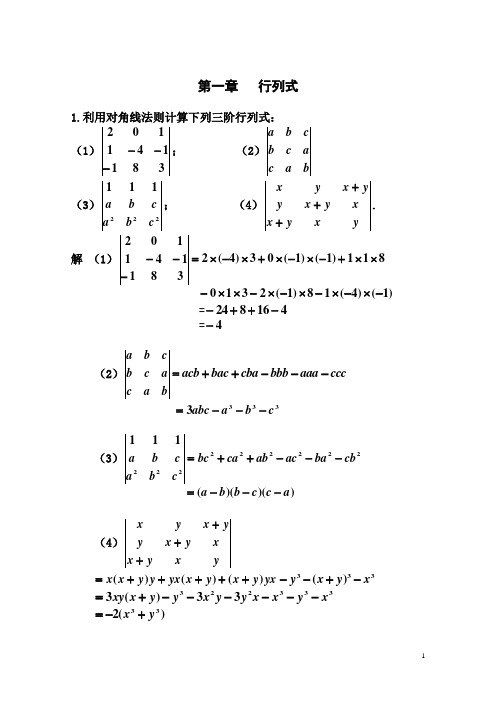
第一章 行列式1.利用对角线法则计算下列三阶行列式:(1)381141102---; (2)b a c a c b cb a (3)222111c b a c b a; (4)yxy x x y x yy x y x+++.解 (1)=---381141102811)1()1(03)4(2⨯⨯+-⨯-⨯+⨯-⨯)1()4(18)1(2310-⨯-⨯-⨯-⨯-⨯⨯-=416824-++- =4-(2)=ba ca cbc b a ccc aaa bbb cba bac acb ---++ 3333c b a abc ---= (3)=222111c b a c b a222222cb ba ac ab ca bc ---++ ))()((a c c b b a ---= (4)yxyx x y x y yx y x+++yx y x y x yx y y x x )()()(+++++=333)(x y x y -+--33322333)(3x y x x y y x y y x xy ------+= )(233y x +-=2.按自然数从小到大为标准次序,求下列各排列的逆序数: (1)1 2 3 4; (2)4 1 3 2; (3)3 4 2 1; (4)2 4 1 3; (5)1 3 … )12(-n 2 4 … )2(n ;(6)1 3 … )12(-n )2(n )22(-n … 2. 解(1)逆序数为0(2)逆序数为4:4 1,4 3,4 2,3 2(3)逆序数为5:3 2,3 1,4 2,4 1,2 1 (4)逆序数为3:2 1,4 1,4 3(5)逆序数为2)1(-n n :3 2 1个 5 2,54 2个 7 2,7 4,7 6 3个 ……………… … )12(-n 2,)12(-n 4,)12(-n 6,…,)12(-n )22(-n)1(-n 个(6)逆序数为)1(-n n3 2 1个 5 2,54 2个 ……………… … )12(-n 2,)12(-n 4,)12(-n 6,…,)12(-n )22(-n)1(-n 个4 2 1个 6 2,6 4 2个 ……………… … )2(n 2,)2(n 4,)2(n 6,…,)2(n )22(-n )1(-n 个3.写出四阶行列式中含有因子2311a a 的项. 解 由定义知,四阶行列式的一般项为43214321)1(p p p p t a a a a -,其中t 为4321p p p p 的逆序数.由于3,121==p p 已固定,4321p p p p 只能形如13□□,即1324或1342.对应的t 分别为10100=+++或22000=+++∴44322311a a a a -和42342311a a a a 为所求.4.计算下列各行列式:(1)⎥⎥⎥⎥⎦⎥⎢⎢⎢⎢⎣⎢71100251020214214; (2)⎥⎥⎥⎥⎦⎥⎢⎢⎢⎢⎣⎢-2605232112131412; (3)⎥⎥⎥⎦⎥⎢⎢⎢⎣⎢---ef cf bf de cd bd ae ac ab ; (4)⎥⎥⎥⎥⎦⎥⎢⎢⎢⎢⎣⎢---d c b a100110011001 解(1)7110025102021421434327c c c c --0100142310202110214---=34)1(143102211014+-⨯--- =143102211014--321132c c c c ++141717201099-=0(2)2605232112131412-24c c -260532122130412-24r r -0412032122130412-14r r -0000032122130412-=0(3)ef cfbfde cd bdaeac ab ---=ecb ec b ec badf ---=111111111---adfbce =abcdef 4(4)d cb a 10110011001---21ar r +d cb a ab 10011011010---+=12)1)(1(+--d c a ab 101101--+ 23dc c +010111-+-+cd c ada ab =23)1)(1(+--cdadab +-+111=1++++ad cd ab abcd5.证明:(1)1112222b b a a b ab a +=3)(b a -;(2)bz ay by ax bxaz by ax bxaz bzay bxaz bz ay by ax +++++++++=yxzx z yz y xb a )(33+; (3)0)3()2()1()3()2()1()3()2()1()3()2()1(2222222222222222=++++++++++++d d d d c c c c b b b b a a a a ;(4)444422221111d c b a dcbad c b a))()()()((d b c b d a c a b a -----=))((d c b a d c +++-⋅;(5)1221100000100001a x a a a a x x x n n n +----- n n n n a x a x a x ++++=--111 .证明(1)0122222221312a b a b aa b a ab a c c c c ------=左边 ab a b ab a ab 22)1(22213-----=+ 21))((ab a a b a b +--=右边=-=3)(b a (2)bz ay by ax z by ax bx az y bx az bz ay x a ++++++分开按第一列左边bzay by ax x by ax bx az z bxaz bz ay y b +++++++ ++++++002y by ax zx bxaz y z bz ay x a 分别再分bzay y xby ax x zbxaz z y b +++ zyx y x zx z y b y x zx z y z y x a 33+分别再分右边=-+=233)1(yxz x z y zy x b yxzx z yz y x a (3) 2222222222222222)3()2()12()3()2()12()3()2()12()3()2()12(++++++++++++++++=d d d d d c c c c c b b b b b a a a a a 左边9644129644129644129644122222141312++++++++++++---d d d d c c c c b b b b a a a a c c c c c c964496449644964422222++++++++d d dd c c c cb b b b a a a a 分成二项按第二列964419644196441964412222+++++++++d d d c c c b b b a a a949494949464222224232423dd c cb b a ac c c c c c c c ----第二项第一项06416416416412222=+d dd c c c b b b a a a(4) 444444422222220001a d a c ab a ad ac ab aa d a c ab a ---------=左边=)()()(222222222222222a d d a c c a b b a d a c a b ad a c a b --------- =)()()(111))()((222a d d a c c a b b ad ac ab a d ac a b ++++++---=⨯---))()((a d a c a b)()()()()(00122222a b b a d d a b b a c c a b b bd b c a b +-++-++--+ =⨯-----))()()()((b d b c a d a c a b)()()()(112222b d a b bd d b c a b bc c ++++++++ =))()()()((d b c b d a c a b a -----))((d c b a d c +++-(5) 用数学归纳法证明.,1,2212122命题成立时当a x a x a x a x D n ++=+-==假设对于)1(-n 阶行列式命题成立,即 ,122111-----++++=n n n n n a x a x a x D:1列展开按第则n D1110010001)1(11----+=+-x x a xD D n n n n 右边=+=-n n a xD 1 所以,对于n 阶行列式命题成立.6.设n 阶行列式)det(ij a D =,把D 上下翻转、或逆时针旋转 90、或依 副对角线翻转,依次得n nnn a a a a D 11111=, 11112n nn n a a a a D = ,11113a a a a D n nnn =, 证明D D D D D n n =-==-32)1(21,)1(.证明 )det(ij a D =nnn n n n nnnn a a a a a a a a a a D 2211111111111)1(--==∴=--=--nnn n nn n n a a a a a a a a 331122111121)1()1( nnn nn n a a a a111121)1()1()1(---=-- D D n n n n 2)1()1()2(21)1()1(--+-+++-=-=同理可证nnnn n n a a a a D 11112)1(2)1(--=D D n n T n n 2)1(2)1()1()1(---=-=D D D D D n n n n n n n n =-=--=-=----)1(2)1(2)1(22)1(3)1()1()1()1(7.计算下列各行列式(阶行列式为k D k ):(1)aaD n 11=,其中对角线上元素都是a ,未写出的元素都是0;(2)xa a ax a aa x D n =;(3) 1111)()1()()1(1111n a a a n a a a n a a a D n n n n n n n ------=---+; 提示:利用范德蒙德行列式的结果.(4) nnnnn d c d c b a b a D000011112=;(5)j i a a D ij ij n -==其中),det(;(6)nn a a a D +++=11111111121,021≠n a a a 其中.解(1) aa aa a D n 00010000000000001000=按最后一行展开)1()1(100000000010000)1(-⨯-+-n n n aa a)1)(1(2)1(--⋅-+n n n a aa(再按第一行展开)n n n nn a a a+-⋅-=--+)2)(2(1)1()1(2--=n n a a )1(22-=-a a n(2)将第一行乘)1(-分别加到其余各行,得ax x a a x xa a x x a a a a x D n ------=0000000 再将各列都加到第一列上,得ax a x a x a a a an x D n ----+=0000000000)1( )(])1([1a x a n x n --+=-(3)从第1+n 行开始,第1+n 行经过n 次相邻对换,换到第1行,第n行经)1(-n 次对换换到第2行…,经2)1(1)1(+=++-+n n n n 次行交换,得nn nn n n n n n n a a a n a a a n a a a D )()1()()1(1111)1(1112)1(1-------=---++此行列式为范德蒙德行列式∏≥>≥++++--+--=112)1(1)]1()1[()1(j i n n n n j a i a D∏∏≥>≥+++-++≥>≥++-∙-∙-=---=1121)1(2)1(112)1()][()1()1()]([)1(j i n n n n n j i n n n j i j i∏≥>≥+-=11)(j i n j i(4) nnnnn d c d c b a b a D 0011112=n n n n n nd d c d c b a b a a 00000011111111----展开按第一行0000)1(1111111112c d c d c b a b a b nn n n n nn ----+-+2222---n n n n n n D c b D d a 都按最后一行展开 由此得递推公式:222)(--=n n n n n n D c b d a D 即 ∏=-=ni i i i i n D c b d a D 222)(而 111111112c b d a d c b a D -==得 ∏=-=ni i i i i n c b d a D 12)((5)j i a ij -=432140123310122210113210)det(--------==n n n n n n n n a D ij n,3221r r r r --0432111111111111111111111--------------n n n n ,,141312c c c c c c +++1524232102221002210002100001---------------n n n n n=212)1()1(----n n n(6)n n a a a D +++=11111111121,,433221c c c c c c ---nn n n a a a a a a a a a a +-------10000100010000100010001000011433221展开(由下往上)按最后一列))(1(121-+n n a a a a nn n a a a a a a a a a --------0000000000000000000000022433221n n n a a a a a a a a ----+--000000000000000001133221 ++ nn n a a a a a a a a -------0000000000000001143322n n n n n n a a a a a a a a a a a a 322321121))(1(++++=---)11)((121∑+==n i in a a a a8.用克莱姆法则解下列方程组:⎪⎪⎩⎪⎪⎨⎧=+++-=----=+-+=+++;01123,2532,242,5)1(4321432143214321x x x x x x x x x x x x x x x x ⎪⎪⎪⎩⎪⎪⎪⎨⎧=+=++=++=++=+.15,065,065,065,165)2(5454343232121x x x x x x x x x x x x x 解 (1)11213513241211111----=D 8120735032101111------=14508130032101111---=14214205410032101111-=---=112105132412211151------=D 11210513290501115----=112123313090509151------=233130905112109151------=1202300461000112109151-----=14238100112109151----=142-=112035122412111512-----=D 811507312032701151-------=31390011230023101151-=28428401910023101151-=----=42611135232422115113-=----=D14202132132********4=-----=D1,3,2,144332211-========∴DD x D D x D D x DD x(2)510006510006510065100065=D 展开按最后一行61000510065100655-'D D D ''-'=65D D D ''-'''-''=6)65(5D D '''-''=3019D D ''''-'''=1146566551141965=⨯-⨯=(,11的余子式中为行列式a D D ',11的余子式中为a D D ''''类推D D ''''''',) 5100165100065100650000611=D 展开按第一列6510065100650006+'D46+'=D 460319+''''-'''=D 1507=5101065100065000601000152=D 展开按第二列5100651006500061-6510065*********-365510651065⨯-=1145108065-=--=5110065000060100051001653=D 展开按第三列51006500061000516500061*********+6100510656510650061+=703114619=⨯+= 5100060100005100651010654=D 展开按第四列61000510065100655000610005100651--51065106565--=395-=110005100065100651100655=D 展开按最后一列D '+1000510********12122111=+=665212;665395;665703;6651145;665150744321=-==-==∴x x x x x . 9.齐次线性方程组取何值时问,,μλ⎪⎩⎪⎨⎧=++=++=++0200321321321x x x x x x x x x μμλ有非零解?解 μλμμμλ-==12111113D ,齐次线性方程组有非零解,则03=D 即 0=-μλμ 得 10==λμ或不难验证,当,10时或==λμ该齐次线性方程组确有非零解.10.齐次线性方程组取何值时问,λ⎪⎩⎪⎨⎧=-++=+-+=+--0)1(0)3(2042)1(321321321x x x x x x x x x λλλ有非零解? 解λλλ----=111132421D λλλλ--+--=101112431)3)(1(2)1(4)3()1(3λλλλλ-------+-= 3)1(2)1(23-+-+-=λλλ 齐次线性方程组有非零解,则0=D 得 32,0===λλλ或不难验证,当32,0===λλλ或时,该齐次线性方程组确有非零解.第二章 矩阵及其运算1.已知线性变换: ⎪⎩⎪⎨⎧++=++=++=,323,53,22321332123211y y y x y y y x y y y x 求从变量321,,x x x 到变量321,,y y y 的线性变换.解由已知:⎪⎪⎪⎭⎫ ⎝⎛⎪⎪⎪⎭⎫ ⎝⎛=⎪⎪⎪⎭⎫ ⎝⎛221321323513122y y y x x x故 ⎪⎪⎪⎭⎫ ⎝⎛⎪⎪⎪⎭⎫ ⎝⎛=⎪⎪⎪⎭⎫ ⎝⎛-3211221323513122x x x y y y ⎪⎪⎪⎭⎫⎝⎛⎪⎪⎪⎭⎫⎝⎛----=321423736947y y y ⎪⎩⎪⎨⎧-+=-+=+--=321332123211423736947xx x y x x x y x x x y2.已知两个线性变换 ⎪⎩⎪⎨⎧++=++-=+=,54,232,232133212311y y y x y y y x y y x ⎪⎩⎪⎨⎧+-=+=+-=,3,2,3323312211z z y z z y z z y 求从321,,z z z 到321,,x x x 的线性变换.解 由已知⎪⎪⎪⎭⎫ ⎝⎛⎪⎪⎪⎭⎫ ⎝⎛-=⎪⎪⎪⎭⎫ ⎝⎛221321514232102y y y x x x ⎪⎪⎪⎭⎫ ⎝⎛⎪⎪⎪⎭⎫ ⎝⎛--⎪⎪⎪⎭⎫⎝⎛-=321310102013514232102z z z⎪⎪⎪⎭⎫ ⎝⎛⎪⎪⎪⎭⎫ ⎝⎛----=321161109412316z z z 所以有 ⎪⎩⎪⎨⎧+--=+-=++-=3213321232111610941236zz z x z z z x z z z x3.设⎪⎪⎪⎭⎫ ⎝⎛--=111111111A , ,150421321⎪⎪⎪⎭⎫⎝⎛--=B 求.23B A A AB T 及-解A AB 23-⎪⎪⎪⎭⎫ ⎝⎛--⎪⎪⎪⎭⎫ ⎝⎛--=1504213211111111113⎪⎪⎪⎭⎫ ⎝⎛---1111111112⎪⎪⎪⎭⎫ ⎝⎛-=0926508503⎪⎪⎪⎭⎫ ⎝⎛---1111111112⎪⎪⎪⎭⎫ ⎝⎛----=22942017222132 ⎪⎪⎪⎭⎫ ⎝⎛--⎪⎪⎪⎭⎫ ⎝⎛--=150421321111111111B A T⎪⎪⎪⎭⎫ ⎝⎛-=0926508504.计算下列乘积: (1)⎪⎪⎪⎭⎫ ⎝⎛⎪⎪⎪⎭⎫ ⎝⎛-127075321134; (2)()⎪⎪⎪⎭⎫ ⎝⎛1233,2,1; (3)()2,1312-⎪⎪⎪⎭⎫ ⎝⎛; (4)⎪⎪⎪⎪⎪⎭⎫⎝⎛---⎪⎪⎭⎫ ⎝⎛-20413121013143110412; (5)⎪⎪⎪⎭⎫ ⎝⎛⎪⎪⎪⎭⎫ ⎝⎛321332313232212131211321),,(x x x a a a a a a a a a x x x ;(6)⎪⎪⎪⎪⎪⎭⎫⎝⎛---⎪⎪⎪⎪⎪⎭⎫⎝⎛30003200121013013000120010100121. 解 (1)⎪⎪⎪⎭⎫ ⎝⎛⎪⎪⎪⎭⎫ ⎝⎛-127075321134⎪⎪⎪⎭⎫ ⎝⎛⨯+⨯+⨯⨯+⨯-+⨯⨯+⨯+⨯=102775132)2(71112374⎪⎪⎪⎭⎫⎝⎛=49635(2)()⎪⎪⎪⎭⎫ ⎝⎛123321)10()132231(=⨯+⨯+⨯=(3)()21312-⎪⎪⎪⎭⎫⎝⎛⎪⎪⎪⎭⎫ ⎝⎛⨯-⨯⨯-⨯⨯-⨯=23)1(321)1(122)1(2⎪⎪⎪⎭⎫ ⎝⎛---=632142 (4)⎪⎪⎪⎪⎪⎭⎫ ⎝⎛---⎪⎪⎭⎫ ⎝⎛-20413121013143110412⎪⎪⎭⎫⎝⎛---=6520876 (5)()⎪⎪⎪⎭⎫ ⎝⎛⎪⎪⎪⎭⎫ ⎝⎛321332313232212131211321x x x a a a a a a a a a x x x()333223113323222112313212111x a x a x a x a x a x a x a x a x a ++++++=⎪⎪⎪⎭⎫ ⎝⎛⨯321x x x 322331132112233322222111222x x a x x a x x a x a x a x a +++++= (6) ⎪⎪⎪⎪⎪⎭⎫⎝⎛---⎪⎪⎪⎪⎪⎭⎫⎝⎛3000320012101313000120010100121⎪⎪⎪⎪⎪⎭⎫ ⎝⎛---=9000340042125215.设⎪⎪⎭⎫ ⎝⎛=3121A , ⎪⎪⎭⎫⎝⎛=2101B ,问:(1)BA AB =吗?(2)2222)(B AB A B A ++=+吗? (3)22))((B A B A B A -=-+吗? 解(1)⎪⎪⎭⎫ ⎝⎛=3121A , ⎪⎪⎭⎫⎝⎛=2101B则⎪⎪⎭⎫ ⎝⎛=6443AB ⎪⎪⎭⎫⎝⎛=8321BA BA AB ≠∴ (2) ⎪⎪⎭⎫ ⎝⎛⎪⎪⎭⎫ ⎝⎛=+52225222)(2B A ⎪⎪⎭⎫⎝⎛=2914148但=++222B AB A ⎪⎪⎭⎫ ⎝⎛+⎪⎪⎭⎫ ⎝⎛+⎪⎪⎭⎫ ⎝⎛43011288611483⎪⎪⎭⎫ ⎝⎛=27151610故2222)(B AB A B A ++≠+(3) =-+))((B A B A =⎪⎪⎭⎫ ⎝⎛⎪⎪⎭⎫ ⎝⎛10205222⎪⎪⎭⎫⎝⎛9060而 =-22B A =⎪⎪⎭⎫ ⎝⎛-⎪⎪⎭⎫ ⎝⎛430111483⎪⎪⎭⎫ ⎝⎛7182故 22))((B A B A B A -≠-+6.举反列说明下列命题是错误的: (1)若02=A ,则0=A ;(2)若A A =2,则0=A 或E A =; (3)若AY AX =,且0≠A ,则Y X =.解 (1) 取⎪⎪⎭⎫ ⎝⎛=0010A 02=A ,但0≠A (2) 取⎪⎪⎭⎫ ⎝⎛=0011A A A =2,但0≠A 且E A ≠ (3) 取⎪⎪⎭⎫ ⎝⎛=0001A ⎪⎪⎭⎫ ⎝⎛-=1111X ⎪⎪⎭⎫⎝⎛=1011YAY AX =且0≠A 但Y X ≠7.设⎪⎪⎭⎫ ⎝⎛=101λA ,求kA A A ,,,32 . 解 ⎪⎪⎭⎫ ⎝⎛=⎪⎪⎭⎫ ⎝⎛⎪⎪⎭⎫ ⎝⎛=12011011012λλλA⎪⎪⎭⎫ ⎝⎛=⎪⎪⎭⎫ ⎝⎛⎪⎪⎭⎫ ⎝⎛==1301101120123λλλA A A利用数学归纳法证明: ⎪⎪⎭⎫ ⎝⎛=101λk A k当1=k 时,显然成立,假设k 时成立,则1+k 时⎪⎪⎭⎫ ⎝⎛+=⎪⎪⎭⎫ ⎝⎛⎪⎪⎭⎫ ⎝⎛==1)1(01101101λλλk k A A A k k由数学归纳法原理知:⎪⎪⎭⎫ ⎝⎛=101λk A k8.设⎪⎪⎪⎭⎫ ⎝⎛=λλλ001001A ,求k A .解 首先观察⎪⎪⎪⎭⎫ ⎝⎛⎪⎪⎪⎭⎫ ⎝⎛=λλλλλλ0010010010012A ⎪⎪⎪⎭⎫⎝⎛=222002012λλλλλ⎪⎪⎪⎭⎫ ⎝⎛=⋅=3232323003033λλλλλλA A A由此推测 ⎪⎪⎪⎪⎪⎭⎫ ⎝⎛-=---k k k k k k k k k k k A λλλλλλ0002)1(121)2(≥k用数学归纳法证明:当2=k 时,显然成立.假设k 时成立,则1+k 时,⎪⎪⎪⎭⎫ ⎝⎛⎪⎪⎪⎪⎪⎭⎫ ⎝⎛-=⋅=---+λλλλλλλλλ0010010002)1(1211k k k k k k k k k k k k A A A⎪⎪⎪⎪⎪⎭⎫⎝⎛+++=+-+--+11111100)1(02)1()1(k k k k k k k k k k λλλλλλ 由数学归纳法原理知: ⎪⎪⎪⎪⎪⎭⎫ ⎝⎛-=---k k k k k k k k k k k A λλλλλλ0002)1(1219.设B A ,为n 阶矩阵,且A 为对称矩阵,证明AB B T 也是对称矩阵. 证明 已知:A A T =则 AB B B A B A B B AB B T T T T TT T T ===)()( 从而 AB B T 也是对称矩阵.10.设B A ,都是n 阶对称矩阵,证明AB 是对称矩阵的充分必要条件是 BA AB =.证明 由已知:A A T = B B T =充分性:BA AB =⇒A B AB T T =⇒)(AB AB T= 即AB 是对称矩阵.必要性:AB AB T=)(⇒AB A B T T =⇒AB BA =.11.求下列矩阵的逆矩阵:(1)⎪⎪⎭⎫ ⎝⎛5221; (2)⎪⎪⎭⎫⎝⎛-θθθθcos sin sin cos ; (3)⎪⎪⎪⎭⎫ ⎝⎛---145243121; (4)⎪⎪⎪⎪⎪⎭⎫⎝⎛4121031200210001; (5)⎪⎪⎪⎪⎪⎭⎫⎝⎛2500380000120025; (6)⎪⎪⎪⎪⎭⎫⎝⎛n a a a 0021)0(21≠a a a n解(1)⎪⎪⎭⎫⎝⎛=5221A 1=A1),1(2),1(2,522122111=-⨯=-⨯==A A A A⎪⎪⎭⎫ ⎝⎛--=⎪⎪⎭⎫ ⎝⎛=*122522122111A A A A A *-=A A A 11 故 ⎪⎪⎭⎫ ⎝⎛--=-12251A(2)01≠=A 故1-A 存在θθθθcos sin sin cos 22122111=-===A A A A从而 ⎪⎪⎭⎫ ⎝⎛-=-θθθθcos sin sin cos 1A(3) 2=A , 故1-A 存在024312111==-=A A A而 1613322212-==-=A A A 21432332313-==-=A A A故 *-=A A A 11⎪⎪⎪⎭⎫⎝⎛-----=1716213213012(4)⎪⎪⎪⎪⎪⎭⎫ ⎝⎛=4121031200210001A 24=A 0434232413121======A A A A A A 68122444332211====A A A A12411032001)1(312-=-=A 12421012021)1(413-=-=A3121312021)1(514=-=A 4421012001)1(523-=-=A5121312001)1(624-=-=A 2121021001)1(734-=-=A*-=A A A 11故⎪⎪⎪⎪⎪⎪⎪⎭⎫ ⎝⎛-----=-4112124581031612100212100011A (5)01≠=A 故1-A 存在而 002141312111==-==A A A A 005242322212===-=A A A A320043332313-====A A A A 850044342414=-===A A A A从而⎪⎪⎪⎪⎪⎭⎫ ⎝⎛----=-85003200005200211A (6)⎪⎪⎪⎪⎭⎫ ⎝⎛=n a a a A 0021 由对角矩阵的性质知 ⎪⎪⎪⎪⎪⎪⎪⎭⎫ ⎝⎛=-n a a a A 1001121112.解下列矩阵方程:(1) ⎪⎪⎭⎫⎝⎛-=⎪⎪⎭⎫ ⎝⎛12643152X ; (2) ⎪⎪⎭⎫ ⎝⎛-=⎪⎪⎪⎭⎫ ⎝⎛--234311111012112X ; (3) ⎪⎪⎭⎫ ⎝⎛-=⎪⎪⎭⎫ ⎝⎛-⎪⎪⎭⎫ ⎝⎛-101311022141X ;(4) ⎪⎪⎪⎭⎫ ⎝⎛---=⎪⎪⎪⎭⎫ ⎝⎛⎪⎪⎪⎭⎫ ⎝⎛021102341010100001100001010X .解(1) ⎪⎪⎭⎫ ⎝⎛-⎪⎪⎭⎫ ⎝⎛=-126431521X ⎪⎪⎭⎫ ⎝⎛-⎪⎪⎭⎫ ⎝⎛--=12642153⎪⎪⎭⎫⎝⎛-=80232 (2) 1111012112234311-⎪⎪⎪⎭⎫⎝⎛--⎪⎪⎭⎫ ⎝⎛-=X ⎪⎪⎪⎭⎫⎝⎛---⎪⎪⎭⎫ ⎝⎛-=03323210123431131⎪⎪⎭⎫ ⎝⎛---=32538122 (3) 11110210132141--⎪⎪⎭⎫ ⎝⎛-⎪⎪⎭⎫ ⎝⎛-⎪⎪⎭⎫ ⎝⎛-=X ⎪⎪⎭⎫ ⎝⎛⎪⎪⎭⎫ ⎝⎛-⎪⎪⎭⎫ ⎝⎛-=210110131142121 ⎪⎪⎭⎫ ⎝⎛⎪⎪⎭⎫ ⎝⎛=21010366121⎪⎪⎭⎫ ⎝⎛=04111 (4) 11010100001021102341100001010--⎪⎪⎪⎭⎫ ⎝⎛⎪⎪⎪⎭⎫ ⎝⎛---⎪⎪⎪⎭⎫ ⎝⎛=X⎪⎪⎪⎭⎫ ⎝⎛⎪⎪⎪⎭⎫ ⎝⎛---⎪⎪⎪⎭⎫ ⎝⎛=010100001021102341100001010⎪⎪⎪⎭⎫ ⎝⎛---=20143101213.利用逆矩阵解下列线性方程组:(1) ⎪⎩⎪⎨⎧=++=++=++;353,2522,132321321321x x x x x x x x x (2) ⎪⎩⎪⎨⎧=-+=--=--.0523,132,2321321321x x x x x x x x x解 (1) 方程组可表示为 ⎪⎪⎪⎭⎫⎝⎛=⎪⎪⎪⎭⎫ ⎝⎛⎪⎪⎪⎭⎫ ⎝⎛321153522321321x x x故 ⎪⎪⎪⎭⎫⎝⎛=⎪⎪⎪⎭⎫ ⎝⎛⎪⎪⎪⎭⎫ ⎝⎛=⎪⎪⎪⎭⎫ ⎝⎛-0013211535223211321x x x从而有 ⎪⎩⎪⎨⎧===001321x x x(2) 方程组可表示为 ⎪⎪⎪⎭⎫ ⎝⎛=⎪⎪⎪⎭⎫ ⎝⎛⎪⎪⎪⎭⎫ ⎝⎛-----012523312111321x x x故 ⎪⎪⎪⎭⎫ ⎝⎛=⎪⎪⎪⎭⎫ ⎝⎛⎪⎪⎪⎭⎫ ⎝⎛-----=⎪⎪⎪⎭⎫ ⎝⎛-3050125233121111321x x x故有 ⎪⎩⎪⎨⎧===305321x x x14.设O A k =(k 为正整数),证明 121)(--++++=-k A A A E A E .证明 一方面, )()(1A E A E E --=- 另一方面,由O A k =有)()()(1122k k k A A A A A A A E E -+--+-+-=-- ))((12A E A A A E k -++++=-故 )()(1A E A E ---))((12A E A A A E k -++++=- 两端同时右乘1)(--A E就有121)(--++++=-k A A A E A E15.设方阵A 满足O E A A =--22,证明A 及E A 2+都可逆,并求1-A 及1)2(-+E A .证明 由O E A A =--22得E A A 22=- 两端同时取行列式: 22=-A A 即 2=-E A A ,故 0≠A 所以A 可逆,而22A E A =+0222≠==+A A E A 故E A 2+也可逆. 由O E A A =--22E E A A 2)(=-⇒E A E A A A 112)(--=-⇒)(211E A A -=⇒-又由O E A A =--22E E A A E A 4)2(3)2(-=+-+⇒ E E A E A 4)3)(2(-=-+⇒11)2(4)3)(2()2(--+-=-++∴E A E A E A E A)3(41)2(1A E E A -=+∴-16.设⎪⎪⎪⎭⎫ ⎝⎛-=321011330A ,B A AB 2+=,求B .解 由B A AB 2+=可得A B E A =-)2(故A E A B 1)2(--=⎪⎪⎪⎭⎫ ⎝⎛-⎪⎪⎪⎭⎫ ⎝⎛---=-3210113301210113321⎪⎪⎪⎭⎫⎝⎛-=01132133017.设Λ=-AP P 1,其中⎪⎪⎭⎫ ⎝⎛--=1141P ,⎪⎪⎭⎫ ⎝⎛-=Λ2001,求11A . 解 Λ=-AP P 1故1-Λ=P P A 所以11111-Λ=P P A3=P ⎪⎪⎭⎫ ⎝⎛-=*1141P ⎪⎪⎭⎫ ⎝⎛--=-1141311P而 ⎪⎪⎭⎫ ⎝⎛-=⎪⎪⎭⎫ ⎝⎛-=Λ11111120012001故⎪⎪⎪⎪⎭⎫ ⎝⎛--⎪⎪⎭⎫ ⎝⎛-⎪⎪⎭⎫ ⎝⎛--=31313431200111411111A ⎪⎪⎭⎫ ⎝⎛--=6846832732273118.设m 次多项式m m x a x a x a a x f ++++= 2210)(,记m m A a A a A a E a A f ++++= 2210)()(A f 称为方阵A 的m 次多项式.(1)设⎪⎪⎭⎫ ⎝⎛=Λ2100λλ,证明: ⎪⎪⎭⎫ ⎝⎛=Λk kk2100λλ,⎪⎪⎭⎫ ⎝⎛=Λ)(00)()(21λλf f f ; (2)设1-Λ=P P A ,证明: 1-Λ=P P A k k ,1)()(-Λ=P Pf A f . 证明(1) i)利用数学归纳法.当2=k 时⎪⎪⎭⎫ ⎝⎛⎪⎪⎭⎫ ⎝⎛=Λ212120000λλλλ⎪⎪⎭⎫ ⎝⎛=222100λλ命题成立,假设k 时成立,则1+k 时⎪⎪⎭⎫ ⎝⎛⎪⎪⎭⎫ ⎝⎛=ΛΛ=Λ+212110000λλλλk k kk ⎪⎪⎭⎫ ⎝⎛=++121100k k λλ故命题成立.ii)左边m m a a a E a f Λ++Λ+Λ+=Λ= 2210)(⎪⎪⎭⎫ ⎝⎛++⎪⎪⎭⎫ ⎝⎛+⎪⎪⎭⎫⎝⎛=m m m a a a 21211000001001λλλλ⎪⎪⎭⎫ ⎝⎛++++++++=m m mm a a a a a a a a 2222210121211000λλλλλλ ⎪⎪⎭⎫ ⎝⎛=)(00)(21λλf f =右边 (2) i) 利用数学归纳法.当2=k 时12112---Λ=ΛΛ=P P P P P P A 成立假设k 时成立,则1+k 时11111-+--+Λ=ΛΛ=⋅=P P P P P P A A A k k k k 成立,故命题成立, 即 1-Λ=P P A k kii) 证明 右边1)(-Λ=P Pf12210)(-Λ++Λ+Λ+=P a a a E a P m m11221110----Λ++Λ+Λ+=P P a P P a P P a PEP a m m m m A a A a A a E a ++++= 2210)(A f ==左边19.设n 阶矩阵A 的伴随矩阵为*A ,证明: (1) 若0=A ,则0=*A ;(2) 1-*=n AA .证明(1) 用反证法证明.假设0≠*A 则有E A A =-**1)( 由此得O A E A A AA A ===-*-**11)()(O A =∴* 这与0≠*A 矛盾,故当0=A 时 有0=*A (2) 由于*-=A AA11, 则E A AA =* 取行列式得到: nA A A =* 若0≠A 则1-*=n AA若0=A 由(1)知0=*A 此时命题也成立故有1-*=n A A20.取⎪⎪⎭⎫⎝⎛==-==1001D C B A ,验证DC BA D CB A ≠ 检验: =D C BA =--10100101101001011010*********002--410012002== 而01111==D C BA 故 D CB A DC BA ≠21.设⎪⎪⎪⎪⎭⎫ ⎝⎛-=22023443O O A ,求8A 及4A 解 ⎪⎪⎪⎪⎭⎫ ⎝⎛-=22023443O O A ,令⎪⎪⎭⎫ ⎝⎛-=34431A ⎪⎪⎭⎫ ⎝⎛=22022A 则⎪⎪⎭⎫ ⎝⎛=21A O O A A故8218⎪⎪⎭⎫ ⎝⎛=A OO A A ⎪⎪⎭⎫⎝⎛=8281A O O A 1682818281810===A A A A A⎪⎪⎪⎪⎪⎭⎫⎝⎛=⎪⎪⎭⎫ ⎝⎛=464444241422025005O O A OO A A22.设n 阶矩阵A 及s 阶矩阵B 都可逆,求1-⎪⎪⎭⎫⎝⎛O B A O .解 将1-⎪⎪⎭⎫⎝⎛O B A O 分块为⎪⎪⎭⎫ ⎝⎛4321C C C C其中 1C 为n s ⨯矩阵, 2C 为s s ⨯矩阵3C 为n n ⨯矩阵, 4C 为s n ⨯矩阵 则⎪⎪⎭⎫ ⎝⎛⨯⨯O B A O s s n n ⎪⎪⎭⎫ ⎝⎛4321C C C C ==E ⎪⎪⎭⎫⎝⎛s n E O O E 由此得到⎪⎪⎩⎪⎪⎨⎧=⇒==⇒==⇒==⇒=----122111144133)()(B C E BC B O C O BC A O C O AC A C E AC s n 存在存在 故 ⎪⎪⎭⎫ ⎝⎛=⎪⎪⎭⎫⎝⎛---O A B O O B A O 111.第三章 矩阵的初等变换与线性方程组1.把下列矩阵化为行最简形矩阵:(1) ⎪⎪⎪⎭⎫ ⎝⎛--340313021201; (2) ⎪⎪⎪⎭⎫ ⎝⎛----174034301320;(3) ⎪⎪⎪⎪⎪⎭⎫ ⎝⎛---------12433023221453334311; (4) ⎪⎪⎪⎪⎪⎭⎫ ⎝⎛------34732038234202173132.解 (1) ⎪⎪⎪⎭⎫ ⎝⎛--3403130212011312)3()2(~r r r r -+-+⎪⎪⎪⎭⎫ ⎝⎛---020*********)2()1(32~-÷-÷r r ⎪⎪⎪⎭⎫ ⎝⎛--01003100120123~r r -⎪⎪⎪⎭⎫⎝⎛--300031001201 33~÷r ⎪⎪⎪⎭⎫ ⎝⎛--100031001201323~r r +⎪⎪⎪⎭⎫⎝⎛-1000010012013121)2(~r r r r +-+⎪⎪⎪⎭⎫⎝⎛100001000001(2) ⎪⎪⎪⎭⎫ ⎝⎛----174034301320 1312)2()3(2~r r r r -+-+⨯⎪⎪⎪⎭⎫⎝⎛---310031001320 21233~r r r r ++⎪⎪⎪⎭⎫ ⎝⎛000031001002021~÷r ⎪⎪⎪⎭⎫ ⎝⎛000031005010 (3) ⎪⎪⎪⎪⎪⎭⎫⎝⎛---------12433023221453334311 141312323~r r r r r r ---⎪⎪⎪⎪⎪⎭⎫ ⎝⎛--------1010500663008840034311 )5()3()4(432~-÷-÷-÷r r r ⎪⎪⎪⎪⎪⎭⎫⎝⎛-----221002210022100343112423213~r r r r r r ---⎪⎪⎪⎪⎪⎭⎫⎝⎛---00000000002210032011(4) ⎪⎪⎪⎪⎪⎭⎫⎝⎛------34732038234202173132 242321232~r r r r r r ---⎪⎪⎪⎪⎪⎭⎫ ⎝⎛-----1187701298804202111110141312782~r r r r r r --+⎪⎪⎪⎪⎪⎭⎫⎝⎛--4100041000202011111034221)1(~r r r r r --⨯↔⎪⎪⎪⎪⎪⎭⎫⎝⎛----0000041000111102020132~r r +⎪⎪⎪⎪⎪⎭⎫⎝⎛--000004100030110202012.在秩是r 的矩阵中,有没有等于0的1-r 阶子式?有没有等于0的r 阶 子式?解 在秩是r 的矩阵中,可能存在等于0的1-r 阶子式,也可能存在等 于0的r 阶子式.例如,⎪⎪⎪⎪⎪⎪⎭⎫ ⎝⎛=00000000010000100001α3)(=αR 同时存在等于0的3阶子式和2阶子式.3.从矩阵A 中划去一行得到矩阵B ,问B A ,的秩的关系怎样? 解 )(A R ≥)(B R设r B R =)(,且B 的某个r 阶子式0≠D r .矩阵B 是由矩阵A 划去一行得到的,所以在A 中能找到与D r 相同的r 阶子式D r ,由于0≠=D D r r , 故而)()(B R A R ≥.4.求作一个秩是4的方阵,它的两个行向量是)0,0,1,0,1(,)0,0,0,1,1(- 解 设54321,,,,ααααα为五维向量,且)0,0,1,0,1(1=α,)0,0,0,1,1(2-=α,则所求方阵可为,54321⎪⎪⎪⎪⎪⎪⎭⎫ ⎝⎛=αααααA 秩为4,不妨设⎪⎩⎪⎨⎧===)0,0,0,0,0(),0,0,0,0()0,,0,0,0(55443αααx x 取154==x x 故满足条件的一个方阵为⎪⎪⎪⎪⎪⎪⎭⎫ ⎝⎛-00000100000100000011001015.求下列矩阵的秩,并求一个最高阶非零子式:(1) ⎪⎪⎪⎭⎫ ⎝⎛---443112112013; (2) ⎪⎪⎪⎭⎫⎝⎛-------815073131213123; (3) ⎪⎪⎪⎪⎪⎭⎫ ⎝⎛---02301085235703273812.解 (1) ⎪⎪⎪⎭⎫ ⎝⎛---443112112013r r 21~↔⎪⎪⎪⎭⎫ ⎝⎛---443120131211 ⎪⎪⎪⎭⎫ ⎝⎛------564056401211~12133r r r r 2000056401211~23秩为⎪⎪⎪⎭⎫⎝⎛----r r 二阶子式41113-=-.(2) ⎪⎪⎪⎭⎫ ⎝⎛-------815073131223123⎪⎪⎪⎭⎫⎝⎛---------15273321059117014431~27122113r r r r r r 200000591170144313~23秩为⎪⎪⎪⎭⎫ ⎝⎛-----r r .二阶子式71223-=-.(3) ⎪⎪⎪⎪⎪⎭⎫⎝⎛---02301085235703273812434241322~r r r r r r ---⎪⎪⎪⎪⎪⎭⎫⎝⎛------02301024205363071210 131223~r r r r ++⎪⎪⎪⎪⎪⎭⎫⎝⎛-0230114000016000071210344314211614~r r r r r r r r -÷÷↔↔⎪⎪⎪⎪⎪⎭⎫ ⎝⎛-0000010000712100231秩为3 三阶子式07023855023085570≠=-=-.6.求解下列齐次线性方程组:(1) ⎪⎩⎪⎨⎧=+++=-++=-++;0222,02,02432143214321x x x x x x x x x x x x (2)⎪⎩⎪⎨⎧=-++=--+=-++;05105,0363,02432143214321x x x x x x x x x x x x (3) ⎪⎪⎩⎪⎪⎨⎧=-+-=+-+=-++=+-+;0742,0634,0723,05324321432143214321x x x x x x x x x x x x x x x x (4)⎪⎪⎩⎪⎪⎨⎧=++-=+-+=-+-=+-+.0327,01613114,02332,075434321432143214321x x x x x x x x x x x x x x x x解 (1) 对系数矩阵实施行变换:⎪⎪⎪⎭⎫ ⎝⎛--212211121211⎪⎪⎪⎪⎭⎫⎝⎛---3410013100101~即得⎪⎪⎪⎩⎪⎪⎪⎨⎧==-==4443424134334x x x x x x x x故方程组的解为⎪⎪⎪⎪⎪⎪⎭⎫ ⎝⎛-=⎪⎪⎪⎪⎪⎭⎫ ⎝⎛1343344321k x x x x(2) 对系数矩阵实施行变换:⎪⎪⎪⎭⎫ ⎝⎛----5110531631121⎪⎪⎪⎭⎫ ⎝⎛-000001001021~ 即得⎪⎪⎩⎪⎪⎨⎧===+-=4432242102x x x x x x x x 故方程组的解为⎪⎪⎪⎪⎪⎭⎫ ⎝⎛+⎪⎪⎪⎪⎪⎭⎫ ⎝⎛-=⎪⎪⎪⎪⎪⎭⎫ ⎝⎛10010*********k k x x x x(3) 对系数矩阵实施行变换:⎪⎪⎪⎪⎪⎭⎫ ⎝⎛-----7421631472135132⎪⎪⎪⎪⎪⎭⎫⎝⎛1000010000100001~即得⎪⎪⎩⎪⎪⎨⎧====00004321x x x x故方程组的解为⎪⎪⎩⎪⎪⎨⎧====00004321x x x x(4) 对系数矩阵实施行变换:⎪⎪⎪⎪⎪⎭⎫ ⎝⎛-----3127161311423327543⎪⎪⎪⎪⎪⎪⎭⎫⎝⎛--000000001720171910171317301~即得⎪⎪⎪⎩⎪⎪⎪⎨⎧==-=-=4433432431172017191713173x x x x x x x x x x 故方程组的解为⎪⎪⎪⎪⎪⎪⎭⎫ ⎝⎛--+⎪⎪⎪⎪⎪⎪⎭⎫ ⎝⎛=⎪⎪⎪⎪⎪⎭⎫⎝⎛1017201713011719173214321k k x xx x7.求解下列非齐次线性方程组:(1) ⎪⎩⎪⎨⎧=+=+-=-+;8311,10213,22421321321x x x x x x x x (2) ⎪⎪⎩⎪⎪⎨⎧-=+-=-+-=+-=++;694,13283,542,432z y x z y x z y x z y x(3) ⎪⎩⎪⎨⎧=--+=+-+=+-+;12,2224,12w z y x w z y x w z y x (4) ⎪⎩⎪⎨⎧-=+-+=-+-=+-+;2534,4323,12w z y x w z y x w z y x解 (1) 对系数的增广矩阵施行行变换,有⎪⎪⎭⎫ ⎝⎛----⎪⎪⎪⎭⎫ ⎝⎛--60003411100833180311102132124~2)(=A R 而3)(=B R ,故方程组无解.(2) 对系数的增广矩阵施行行变换:⎪⎪⎪⎪⎪⎭⎫ ⎝⎛-----69141328354214132⎪⎪⎪⎪⎪⎭⎫ ⎝⎛--0000000021101201~即得⎪⎩⎪⎨⎧=+=--=zz z y z x 212亦即⎪⎪⎪⎭⎫⎝⎛-+⎪⎪⎪⎭⎫ ⎝⎛-=⎪⎪⎪⎭⎫ ⎝⎛021112k z y x(3) 对系数的增广矩阵施行行变换:⎪⎪⎪⎭⎫ ⎝⎛----111122122411112⎪⎪⎪⎭⎫ ⎝⎛-000000100011112~ 即得⎪⎪⎪⎩⎪⎪⎪⎨⎧===++-=0212121w z z y y z y x 即⎪⎪⎪⎪⎪⎪⎭⎫ ⎝⎛+⎪⎪⎪⎪⎪⎪⎭⎫ ⎝⎛+⎪⎪⎪⎪⎪⎪⎭⎫ ⎝⎛-=⎪⎪⎪⎪⎪⎭⎫ ⎝⎛00021010210012121k k w z y x(4) 对系数的增广矩阵施行行变换:⎪⎪⎪⎭⎫⎝⎛----⎪⎪⎪⎭⎫ ⎝⎛-----000007579751025341253414312311112~⎪⎪⎪⎪⎪⎪⎭⎫⎝⎛----000007579751076717101~ 即得⎪⎪⎪⎩⎪⎪⎪⎨⎧==--=++=w w z z w z y w z x 757975767171 即⎪⎪⎪⎪⎪⎪⎭⎫ ⎝⎛-+⎪⎪⎪⎪⎪⎪⎭⎫ ⎝⎛-+⎪⎪⎪⎪⎪⎪⎭⎫ ⎝⎛=⎪⎪⎪⎪⎪⎭⎫ ⎝⎛00757610797101757121k k w z y x8.λ取何值时,非齐次线性方程组⎪⎩⎪⎨⎧=++=++=++2321321321,,1λλλλλx x x x x x x x x (1)有唯一解;(2)无解;(3)有无穷多个解?解 (1) 0111111≠λλλ,即2,1-≠λ时方程组有唯一解.(2) )()(B R A R < ⎪⎪⎪⎭⎫ ⎝⎛=21111111λλλλλB ⎪⎪⎭⎫ ⎝⎛+-+----22)1)(1()2)(1(00)1(11011~λλλλλλλλλλ由0)1)(1(,0)2)(1(2≠+-=+-λλλλ得2-=λ时,方程组无解.(3) 3)()(<=B R A R ,由0)1)(1()2)(1(2=+-=+-λλλλ, 得1=λ时,方程组有无穷多个解.9.非齐次线性方程组 ⎪⎩⎪⎨⎧=-+=+--=++-23213213212,2,22λλx x x x x x x x x 当λ取何值时有解?并求出它的解.解 ⎪⎪⎪⎪⎭⎫ ⎝⎛+-----⎪⎪⎪⎭⎫ ⎝⎛----=)2)(1(000)1(321101212111212112~2λλλλλλB 方程组有解,须0)2)(1(=+-λλ得2,1-==λλ当1=λ时,方程组解为⎪⎪⎪⎭⎫ ⎝⎛+⎪⎪⎪⎭⎫ ⎝⎛=⎪⎪⎪⎭⎫ ⎝⎛001111321k x x x当2-=λ时,方程组解为⎪⎪⎪⎭⎫ ⎝⎛+⎪⎪⎪⎭⎫ ⎝⎛=⎪⎪⎪⎭⎫ ⎝⎛022111321k x x x10.设⎪⎩⎪⎨⎧--=-+--=--+=-+-,1)5(42,24)5(2,122)2(321321321λλλλx x x x x x x x x问λ为何值时,此方程组有唯一解、无解或有无穷多解?并在有无穷多解时求解.解 ⎪⎪⎪⎭⎫ ⎝⎛---------154224521222λλλλ初等行变换~⎪⎪⎪⎪⎪⎭⎫⎝⎛---------2)4)(1(2)10)(1(00111012251λλλλλλλλ当0≠A ,即02)10()1(2≠--λλ 1≠∴λ且10≠λ时,有唯一解.当02)10)(1(=--λλ且02)4)(1(≠--λλ,即10=λ时,无解.当02)10)(1(=--λλ且02)4)(1(=--λλ,即1=λ时,有无穷多解.此时,增广矩阵为⎪⎪⎪⎭⎫ ⎝⎛-000000001221原方程组的解为⎪⎪⎪⎭⎫ ⎝⎛+⎪⎪⎪⎭⎫ ⎝⎛+⎪⎪⎪⎭⎫ ⎝⎛-=⎪⎪⎪⎭⎫ ⎝⎛00110201221321k k x x x (R k k ∈21,)11.试利用矩阵的初等变换,求下列方阵的逆矩阵:(1) ⎪⎪⎪⎭⎫⎝⎛323513123; (2) ⎪⎪⎪⎪⎪⎭⎫ ⎝⎛-----1210232112201023. 解 (1)⎪⎪⎪⎭⎫ ⎝⎛100010001323513123⎪⎪⎪⎭⎫ ⎝⎛---101011001200410123~⎪⎪⎪⎪⎪⎭⎫ ⎝⎛----10121121023200010023~⎪⎪⎪⎪⎪⎭⎫⎝⎛----2102121129227100010003~⎪⎪⎪⎪⎪⎭⎫⎝⎛----21021211233267100010001~故逆矩阵为⎪⎪⎪⎪⎪⎭⎫ ⎝⎛----21021211233267(2) ⎪⎪⎪⎪⎪⎭⎫ ⎝⎛-----10000100001000011210232112201023 ⎪⎪⎪⎪⎪⎭⎫ ⎝⎛----00100301100001001220594012102321~ ⎪⎪⎪⎪⎪⎭⎫ ⎝⎛--------20104301100001001200110012102321~。
同济大学2019-2020学年第一学期C 语言程序设计试题及答案(三)
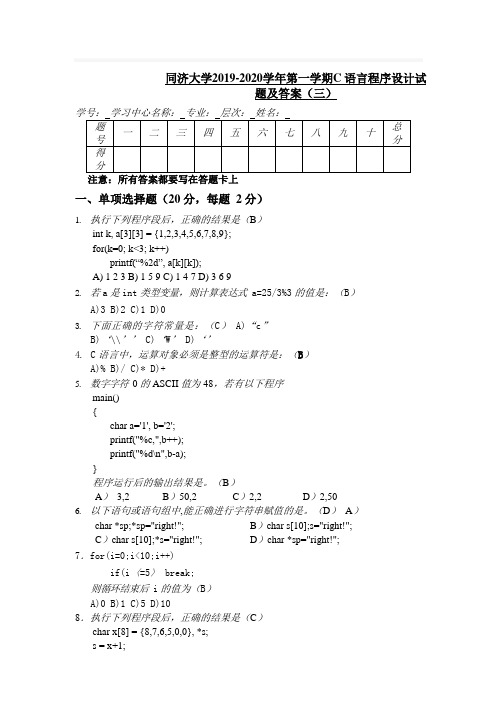
同济大学2019-2020学年第一学期C 语言程序设计试题及答案(三)一、单项选择题(20 分,每题 2 分)1.执行下列程序段后,正确的结果是(B)int k, a[3][3] = {1,2,3,4,5,6,7,8,9};for(k=0; k<3; k++)printf(“%2d”, a[k][k]);A) 1 2 3 B) 1 5 9 C) 1 4 7 D) 3 6 92.若a 是int 类型变量,则计算表达式a=25/3%3 的值是:(B)A)3 B)2 C)1 D)03.下面正确的字符常量是:(C)A)“c”B)‘\\’’ C)‘W’ D)‘’4. C 语言中,运算对象必须是整型的运算符是:(B)A)% B)/ C)* D)+5.数字字符0 的ASCII 值为48,若有以下程序main(){char a='1', b='2';printf("%c,",b++);printf("%d\n",b-a);}程序运行后的输出结果是。
(B)A)3,2 B)50,2 C)2,2 D)2,506.以下语句或语句组中,能正确进行字符串赋值的是。
(D)A)char *sp;*sp="right!"; B)char s[10];s="right!";C)char s[10];*s="right!"; D)char *sp="right!";7.for(i=0;i<10;i++)if(i〈=5〉break;则循环结束后i 的值为(B)A)0 B)1 C)5 D)108.执行下列程序段后,正确的结果是(C)char x[8] = {8,7,6,5,0,0}, *s;s = x+1;printf(“%d\n”, s[2]);A) n B) 0 C) 5 D) 69.C 语言规定,简单变量作为实参时,他和对应形参之间的数据传递方式是:AA)单向值传递B) 地址传递C) 相互传递D) 由用户指定方式10.设有数组定义:char str[]=”China”;则下面的输出为(C)printf(“%d”,strlen(str));A)4 B)5 C)6 D)7二、填空题(30 分,每空 2 分)1.下列程序段的输出结果是3 。
呼吸病学同济大学答案
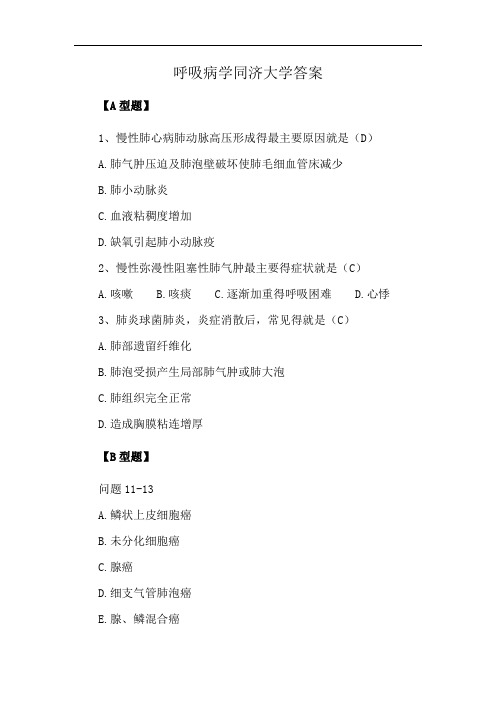
呼吸病学同济大学答案【A型题】1、慢性肺心病肺动脉高压形成得最主要原因就是(D)A.肺气肿压迫及肺泡壁破坏使肺毛细血管床减少B.肺小动脉炎C.血液粘稠度增加D.缺氧引起肺小动脉疫2、慢性弥漫性阻塞性肺气肿最主要得症状就是(C)A.咳嗽B.咳痰C.逐渐加重得呼吸困难D.心悸3、肺炎球菌肺炎,炎症消散后,常见得就是(C)A.肺部遗留纤维化B.肺泡受损产生局部肺气肿或肺大泡C.肺组织完全正常D.造成胸膜粘连增厚【B型题】问题11-13A.鳞状上皮细胞癌B.未分化细胞癌C.腺癌D.细支气管肺泡癌E.腺、鳞混合癌11、对放射治疗及化疗最敏感得肺癌就是(B)12、手术治疗效果最好得肺癌就是(A)13、最常见得周围肺癌就是(C)问题14-15A.原发型肺结核B.血行播散型肺结核C.继发型肺结核D.结核性胸膜炎E.肺外结核14、成年人最常见得肺结核类型就是(C)15、60岁男性患者,既往有肺结核史及慢性咳嗽史,X线胸片发现左上肺大片密度增高影,内有透光区,左肺门上提,气管及纵隔向左移,应诊断为(C)【X型题】20、慢性支气管炎可分为(AC)A.单纯型B.气肿型C.喘息型D.混合型21、下列哪些项目可作为诊断慢性肺心病得条件(ACD)A.慢性肺、胸疾病史B.左室肥大或左心衰竭C.右室肥大或右心衰竭D.肺动脉高压表现23、下列疾病抗感染治疗得原则,哪些就是正确得(ABD)A.肺炎球菌肺炎首选青霉互G治疗,体温正常3天后停药B.金黄色葡萄球菌肺炎可选用青霉素及1代头孢霉素C.克雷白杆菌肺炎首选大环内酯类抗生素治疗呼吸系统疾病D.体温正常,咳痰基本消失即可停药。
【填空题】1、肺结核化疗得原则就是(早期)、(联用适量)、(规律)。
2、按组织学特征,支气管肺癌可分为(鳞状上皮细胞癌)、(未分化细胞癌)、(腥癌)、(支气管肺泡癌)。
3、支气管哮喘可引起(呼气性呼吸困难);气管内肿瘤或异物可引起(吸气性呼吸困难)。
同济大学实验安全考试题库
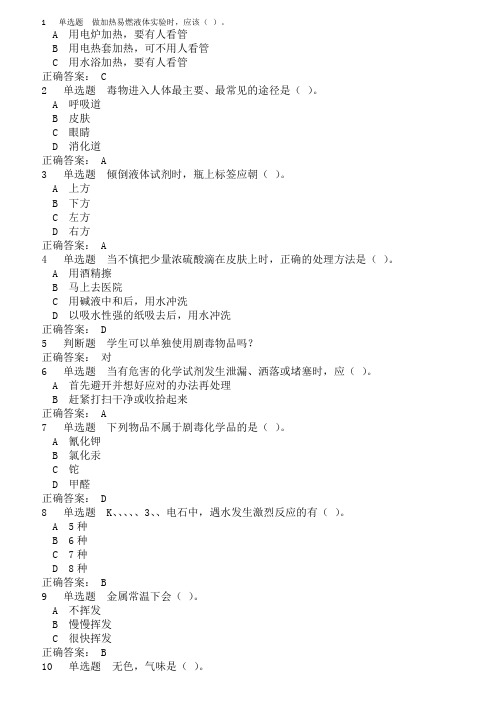
1 单选题做加热易燃液体实验时,应该()。
A 用电炉加热,要有人看管B 用电热套加热,可不用人看管C 用水浴加热,要有人看管正确答案: C2 单选题毒物进入人体最主要、最常见的途径是()。
A 呼吸道B 皮肤C 眼睛D 消化道正确答案: A3 单选题倾倒液体试剂时,瓶上标签应朝()。
A 上方B 下方C 左方D 右方正确答案: A4 单选题当不慎把少量浓硫酸滴在皮肤上时,正确的处理方法是()。
A 用酒精擦B 马上去医院C 用碱液中和后,用水冲洗D 以吸水性强的纸吸去后,用水冲洗正确答案: D5 判断题学生可以单独使用剧毒物品吗?正确答案:对6 单选题当有危害的化学试剂发生泄漏、洒落或堵塞时,应()。
A 首先避开并想好应对的办法再处理B 赶紧打扫干净或收拾起来正确答案: A7 单选题下列物品不属于剧毒化学品的是()。
A 氰化钾B 氯化汞C 铊D 甲醛正确答案: D8 单选题 K、、、、、3、、电石中,遇水发生激烈反应的有()。
A 5种B 6种C 7种D 8种正确答案: B9 单选题金属常温下会()。
A 不挥发B 慢慢挥发C 很快挥发正确答案: B10 单选题无色,气味是()。
A 无味B 大蒜味C 苦杏仁味正确答案: C11 单选题氮氧化物主要伤害人体的()器官。
A 眼、上呼吸道B 呼吸道深部的细支气管、肺泡正确答案: B12 单选题易燃易爆试剂应放在()。
A 在铁柜中,柜的顶部要有通风口B 在木柜中,柜的顶部要有通风口C 在铁柜中,并要密封保存D 在木柜中,并要密封保存正确答案: A13 多选题以下哪些酸具有强腐蚀性,使用时须做必要的防护()。
A 硝酸B 冰醋酸C 硼酸正确答案:14 多选题使用易燃易爆的化学药品应该注意()。
A 避免明火加热B 加热时使用水浴或油浴C 在通风橱中进行操作D 不可猛烈撞击正确答案:15 多选题剧毒类化学试剂应如何存放()。
A 应锁在专门的毒品柜中B 应存于实验台下柜中C 置于阴凉干燥处,并与酸类试剂隔离D 建立双人登记签字领用制度,建立使用、消耗、废物处理等制度E 储存室应配备防毒、防盗、报警与隔离、消除与吸收毒物的设施正确答案:16 多选题爆炸物品在发生爆炸时的特点有()。
上海同济大学实验学校八年级上册压轴题数学模拟试卷及答案
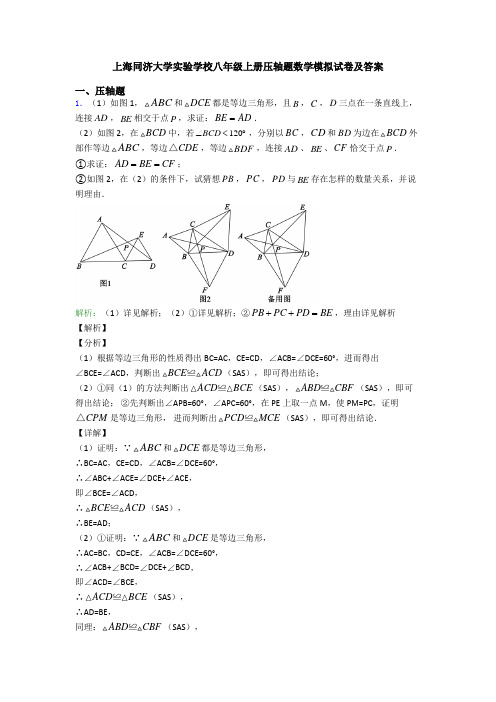
上海同济大学实验学校八年级上册压轴题数学模拟试卷及答案一、压轴题1.(1)如图1,ABC 和DCE 都是等边三角形,且B ,C ,D 三点在一条直线上,连接AD ,BE 相交于点P ,求证:BE AD =.(2)如图2,在BCD 中,若120BCD ∠<︒,分别以BC ,CD 和BD 为边在BCD 外部作等边ABC ,等边CDE △,等边BDF ,连接AD 、BE 、CF 恰交于点P . ①求证:AD BE CF ==;②如图2,在(2)的条件下,试猜想PB ,PC ,PD 与BE 存在怎样的数量关系,并说明理由.解析:(1)详见解析;(2)①详见解析;②PB PC PD BE ++=,理由详见解析【解析】【分析】(1)根据等边三角形的性质得出BC=AC ,CE=CD ,∠ACB=∠DCE=60°,进而得出∠BCE=∠ACD ,判断出BCE ACD ≌(SAS ),即可得出结论;(2)①同(1)的方法判断出≌ACD BCE (SAS ),ABD CBF ≌(SAS ),即可得出结论; ②先判断出∠APB=60°,∠APC=60°,在PE 上取一点M ,使PM=PC ,证明CPM △是等边三角形, 进而判断出PCD MCE ≌(SAS ),即可得出结论.【详解】(1)证明:∵ABC 和DCE 都是等边三角形,∴BC=AC ,CE=CD ,∠ACB=∠DCE=60°,∴∠ABC+∠ACE=∠DCE+∠ACE ,即∠BCE=∠ACD ,∴BCE ACD ≌(SAS ),∴BE=AD ;(2)①证明:∵ABC 和DCE 是等边三角形,∴AC=BC ,CD=CE ,∠ACB=∠DCE=60°,∴∠ACB+∠BCD=∠DCE+∠BCD ,即∠ACD=∠BCE ,∴≌ACD BCE (SAS ),∴AD=BE ,同理:ABD CBF ≌(SAS ),∴AD=CF,即AD=BE=CF;②解:结论:PB+PC+PD=BE,理由:如图2,AD与BC的交点记作点Q,则∠AQC=∠BQP,ACD BCE,由①知,≌∴∠CAD=∠CBE,在ACQ中,∠CAD+∠AQC=180°-∠ACB=120°,∴∠CBE+∠BQP=120°,在BPQ中,∠APB=180°-(∠CBE+∠BQP)=60°,∴∠DPE=60°,同理:∠APC=60°,CPE∴∠=︒∠CPD=120°,60,在PE上取一点M,使PM=PC,△是等边三角形,∴CPM==,∠PCM=∠CMP=60°,∴CP CM PM∴∠CME=120°=∠CPD,△是等边三角形,∵CDE∴CD=CE,∠DCE=60°=∠PCM,∴∠PCD=∠MCE,≌(SAS),∴PCD MCE∴PD=ME,∴BE=PB+PM+ME=PB+PC+PD.【点睛】此题是三角形综合题,主要考查了三角形的内角和定理,等边三角形的性质和判定,全等三角形的判定和性质,构造出全等三角形是解本题的关键.2.阅读材料并完成习题:在数学中,我们会用“截长补短”的方法来构造全等三角形解决问题.请看这个例题:如图1,在四边形ABCD中,∠BAD=∠BCD=90°,AB=AD,若AC=2cm,求四边形ABCD的面积.解:延长线段CB到E,使得BE=CD,连接AE,我们可以证明△BAE≌△DAC,根据全等三角形的性质得AE=AC=2, ∠EAB=∠CAD ,则∠EAC=∠EAB+∠BAC=∠DAC+∠BAC=∠BAD=90°,得S 四边形ABCD =S △ABC +S △ADC =S △ABC +S △ABE =S △AEC ,这样,四边形ABCD 的面积就转化为等腰直角三角形EAC 面积.(1)根据上面的思路,我们可以求得四边形ABCD 的面积为 cm 2.(2)请你用上面学到的方法完成下面的习题.如图2,已知FG=FN=HM=GH+MN=2cm ,∠G=∠N=90°,求五边形FGHMN 的面积. 解析:(1)2;(2)4【解析】【分析】(1)根据题意可直接求等腰直角三角形EAC 的面积即可;(2)延长MN 到K ,使NK=GH ,连接FK 、FH 、FM ,由(1)易证FGH FNK ≌,则有FK=FH ,因为HM=GH+MN 易证FMK FMH ≌,故可求解.【详解】(1)由题意知21=22ABC ADC ABC ABE AEC ABCD AC S SS S S S =+=+==四边形, 故答案为2;(2)延长MN 到K ,使NK=GH ,连接FK 、FH 、FM ,如图所示:FG=FN=HM=GH+MN=2cm ,∠G=∠N=90°,∴∠FNK=∠FGH=90°,∴FGH FNK ≌, ∴FH=FK ,又FM=FM ,HM=KM=MN+GH=MN+NK ,∴FMK FMH ≌,∴MK=FN=2cm ,∴12=242FGH HFM MFN FMK FGHMN S S S S S MK FN =++=⨯⋅=五边形.【点睛】本题主要考查全等三角形的性质与判定,关键是根据截长补短法及割补法求面积的运用.3.(阅读材料):(1)在ABC ∆中,若90C ∠=︒,由“三角形内角和为180°”得1801809090A B C ∠︒+∠=-∠︒︒-=︒=.(2)在ABC ∆中,若90A B ∠+∠=︒,由“三角形内角和为180°”得180()1809090C A B ∠=︒-∠+∠=︒-︒=︒.(解决问题):如图①,在平面直角坐标系中,点C 是x 轴负半轴上的一个动点.已知//AB x 轴,交y 轴于点E ,连接CE ,CF 是∠ECO 的角平分线,交AB 于点F ,交y 轴于点D .过E 点作EM 平分∠CEB ,交CF 于点M .(1)试判断EM 与CF 的位置关系,并说明理由;(2)如图②,过E 点作PE ⊥CE ,交CF 于点P .求证:∠EPC=∠EDP ;(3)在(2)的基础上,作EN 平分∠AEP ,交OC 于点N ,如图③.请问随着C 点的运动,∠NEM 的度数是否发生变化?若不变,求出其值:若变化,请说明理由.解析:(1)EM ⊥CF ,理由见解析;(2)证明见解析;(3)不变,且∠NEM=45°,理由见解析.【解析】【分析】(1)EM ⊥CF ,分别利用角平分线的性质、平行线的性质、三角形的内角和定理进行求证即可;(2)根据垂直定义和三角形的内角和定理证得∠DCO+∠CDO=90°,∠ECP+∠EPC=90°,再利用等角的余角相等和对顶角相等即可证得结论;(3)不变,且∠NEM=45°,先利用平行线的性质得到∠AEC=∠ECO=2∠ECP ,进而有∠AEP=∠CEP+∠AEC=90°+2∠ECP ,再由角平分线的定义∠NEP=∠AEN=45°+∠ECP ,再根据同角的余角相等得到∠ECP=∠MEP ,然后等量代换证得∠NEM=45°,是定值.【详解】解:(1)EM ⊥CF ,理由如下:∵CF 平分∠ECO ,EM 平分∠FEC ,∴∠ECF=∠FCO=12ECO ∠,∠FEM=∠CEM=12CEF ∠ ∵AB ∥x 轴1111()180902222ECF CEM ECO CEF ECO CEF ∴∠+∠=∠+∠=∠+∠=⨯︒=︒ ∴∠ECO+∠CEF=180° ∴∠EMC=180°-(∠CEM+∠ECF )=180°-90°=90°∴EM ⊥CF(2)由题得,∠EOC=90°∴∠DCO+∠CDO=180°-∠EOC=180°-90°=90°∵PE ⊥CE∴∠CEP=90°∴∠ECP+∠EPC=180°-∠CEP=180°-90°=90°∵∠DCO=∠ECP∴∠CDO=∠EPC又∵∠CDO=∠EDP∴∠EPC=∠EDP(3)不变,且∠NEM=45°,理由如下:∵AB ∥x 轴∴∠AEC=∠ECO=2∠ECP∴∠AEP=∠CEP+∠AEC=90°+2∠ECP∵EN 平分∠AEP∴∠NEP=∠AEN=12AEP ∠=1(902)2ECP ︒+∠=45°+∠ECP ∵∠CEP=90°∴∠ECP+∠EPC=90°又∵∠EMC=90°∴∠MEP+∠EPC=90°∴∠ECP=∠MEP∴∠NEP=∠NEM+∠MEP=∠NEM+∠ECP又∵∠NEP=45°+∠ECP∴∠NEM=45°.【点睛】本题是一道综合探究题,涉及有平行线的性质、角平分线的定义、三角形的内角和定理、同(等)角的余角相等、对顶角相等、垂线性质等知识,解答的关键是认真审题,结合图形,寻找相关联信息,确定解题思路,进而探究、推理、论证.4.在△ABC中,AB=AC,D是直线BC上一点,以AD为一条边在AD的右侧作△ADE,使AE=AD,∠DAE=∠BAC,连接CE.(1)如图,当点D在BC延长线上移动时,若∠BAC=40°,则∠ACE=,∠DCE=,BC、DC、CE之间的数量关系为;(2)设∠BAC=α,∠DCE=β.①当点D在BC延长线上移动时,α与β之间有什么数量关系?请说明理由;②当点D在直线BC上(不与B,C两点重合)移动时,α与β之间有什么数量关系?请直接写出你的结论.(3)当CE∥AB时,若△ABD中最小角为15°,试探究∠ACB的度数(直接写出结果,无需写出求解过程).解析:(1)70°,40°,BC+DC=CE;(2)①α=β;②当点D在BC上移动时,α=β或α+β=180°;(3)∠ACB=60°.【解析】【分析】(1)证△BAD≌△CAE,推出∠B=∠ACE,根据三角形外角性质和全等三角形的性质求出即可;(2)①证△BAD≌△CAE,推出∠B=∠ACE,根据三角形外角性质求出即可;②分三种情况:(Ⅰ)当D在线段BC上时,证明△ABD≌△ACE(SAS),则∠ADB=∠AEC,∠ABC=∠ACE,推出∠DAE+∠DCE=180°,即α+β=180°;(Ⅱ)当点D在线段BC反向延长线上时,α=β,同理可证明△ABD≌△ACE(SAS),则∠ABD=∠ACE,推出∠BAC=∠DCE,即α=β;(Ⅲ)当点D在线段BC的延长线上时,由①得α=β;(3)当点D在线段BC的延长线上或在线段BC反向延长线上移动时,α=β,由CE∥AB,得∠ABC=∠DCE,推出∠ABC=∠BAC,易证∠ABC=∠ACB=∠BAC,则△ABC是等边三角形,得出∠ACB=60°;当D在线段BC上时,α+β=180°,由CE∥AB,得∠ABC+∠DCE=180°,推出∠ABC=∠BAC,易证∠ABC=∠ACB=∠BAC,则△ABC是等边三角形,得出∠ACB=60°.【详解】(1)如图1所示:∵∠DAE=∠BAC,∴∠DAE+∠CAD=∠BAC+∠CAD,∴∠BAD=∠CAE.在△BAD和△CAE中,AB ACBAD CAE AD AE=⎧⎪∠=∠⎨⎪=⎩,∴△BAD≌△CAE(SAS),∴∠ACE=∠B12=(180°﹣40°)=70°,BD=CE,∴BC+DC=CE.∵∠ACD=∠B+∠BAC=∠ACE+∠DCE,∴∠BAC=∠DCE.∵∠BAC=40°,∴∠DCE=40°.故答案为:70°,40°,BC+DC=CE;(2)①当点D在线段BC的延长线上移动时,α与β之间的数量关系是α=β.理由如下:∵∠DAE=∠BAC,∴∠DAE+∠CAD=∠BAC+∠CAD,∴∠BAD=∠CAE.在△BAD和△CAE中,AB ACBAD CAE AD AE=⎧⎪∠=∠⎨⎪=⎩,∴△BAD≌△CAE(SAS),∴∠B=∠ACE.∵∠ACD=∠B+∠BAC=∠ACE+∠DCE,∴∠BAC=∠DCE.∵∠BAC=α,∠DCE=β,∴α=β;②分三种情况:(Ⅰ)当D在线段BC上时,α+β=180°,如图2所示.理由如下:同理可证明:△ABD≌△ACE(SAS),∴∠ADB=∠AEC,∠ABC=∠ACE.∵∠ADC+∠ADB=180°,∴∠ADC+∠AEC=180°,∴∠DAE+∠DCE=180°.∵∠BAC=∠DAE=α,∠DCE=β,∴α+β=180°;(Ⅱ)当点D在线段BC反向延长线上时,α=β,如图3所示.理由如下:同理可证明:△ABD≌△ACE(SAS),∴∠ABD=∠ACE.∵∠ACE=∠ACD+∠DCE,∠ABD=∠ACD+∠BAC,∴∠ACD+∠DCE=∠ACD+∠BAC,∴∠BAC=∠DCE.∵∠BAC=α,∠DCE=β,∴α=β;(Ⅲ)当点D在线段BC的延长线上时,如图1所示,α=β;综上所述:当点D在BC上移动时,α=β或α+β=180°;(3)∠ACB=60°.理由如下:∵当点D在线段BC的延长线上或在线段BC反向延长线上移动时,α=β,即∠BAC=∠DCE.∵CE∥AB,∴∠ABC=∠DCE,∴∠ABC=∠BAC.∵AB=AC,∴∠ABC=∠ACB=∠BAC,∴△ABC是等边三角形,∴∠ACB=60°;∵当D在线段BC上时,α+β=180°,即∠BAC+∠DCE=180°.∵CE∥AB,∴∠ABC+∠DCE=180°,∴∠ABC=∠BAC.∵AB=AC,∴∠ABC=∠ACB=∠BAC,∴△ABC是等边三角形,∴∠ACB=60°;综上所述:当CE∥AB时,若△ABD中最小角为15°,∠ACB的度数为60°.【点睛】本题是三角形综合题目,考查了全等三角形的判定与性质、等腰三角形的性质、等边三角形的判定与性质、平行线的性质、三角形的外角性质和多边形内角和等知识.本题综合性强,熟练掌握全等三角形的判定与性质是解题的关键.5.问题背景:(1)如图1,已知△ABC中,∠BAC=90°,AB=AC,直线m经过点A,BD⊥直线m,CE⊥直线m,垂足分别为点D、E.求证:DE=BD+CE.拓展延伸:(2)如图2,将(1)中的条件改为:在△ABC中,AB=AC,D、A、E三点都在直线m上,并且有∠BDA=∠AEC=∠BAC.请写出DE、BD、CE三条线段的数量关系.(不需要证明)实际应用:(3)如图,在△ACB中,∠ACB=90°,AC=BC,点C的坐标为(-2,0),点A的坐标为(-6,3),请直接写出B点的坐标.解析:(1)证明见解析;(2)DE =BD +CE ;(3)B(1,4)【解析】【分析】(1)证明△ABD ≌△CAE ,根据全等三角形的性质得到AE=BD ,AD=CE ,结合图形解答即可;(2)根据三角形内角和定理、平角的定义证明∠ABD=∠CAE ,证明△ABD ≌△CAE ,根据全等三角形的性质得到AE=BD ,AD=CE ,结合图形解答即可;(3)根据△AEC ≌△CFB ,得到CF=AE=3,BF=CE=OE-OC=4,根据坐标与图形性质解答.【详解】(1)证明:∵BD ⊥直线m ,CE ⊥直线m ,∴∠ADB =∠CEA =90°∵∠BAC =90°∴∠BAD +∠CAE =90°∵∠BAD +∠ABD =90°∴∠CAE =∠ABD∵在△ADB 和△CEA 中ABD CAE ADB CEA AB CA ∠=∠⎧⎪∠=∠⎨⎪=⎩∴△ADB ≌△CEA (AAS )∴AE =BD ,AD =CE∴DE =AE +AD =BD +CE即:DE =BD +CE(2)解:数量关系:DE =BD +CE理由如下:在△ABD 中,∠ABD=180°-∠ADB-∠BAD ,∵∠CAE=180°-∠BAC-∠BAD ,∠BDA=∠AEC ,∴∠ABD=∠CAE ,在△ABD 和△CAE 中,ABD CAE BDA AEC AB CA ∠∠⎧⎪∠∠⎨⎪⎩===∴△ABD≌△CAE(AAS)∴AE=BD,AD=CE,∴DE=AD+AE=BD+CE;(3)解:如图,作AE⊥x轴于E,BF⊥x轴于F,由(1)可知,△AEC≌△CFB,∴CF=AE=3,BF=CE=OE-OC=4,∴OF=CF-OC=1,∴点B的坐标为B(1,4).【点睛】本题考查的是全等三角形的判定和性质、坐标与图形性质,掌握全等三角形的判定定理和性质定理是解题的关键.6.如图1.在△ABC中,∠ACB=90°,AC=BC=10,直线DE经过点C,过点A,B分别作AD⊥DE,BE⊥DE,垂足分别为点D和E,AD=8,BE=6.(1)①求证:△ADC≌△CEB;②求DE的长;(2)如图2,点M以3个单位长度/秒的速度从点C出发沿着边CA运动,到终点A,点N 以8个单位长度/秒的速度从点B出发沿着线BC—CA运动,到终点A.M,N两点同时出发,运动时间为t秒(t>0),当点N到达终点时,两点同时停止运动,过点M作PM⊥DE 于点P,过点N作QN⊥DE于点Q;①当点N在线段CA上时,用含有t的代数式表示线段CN的长度;②当t为何值时,点M与点N重合;③当△PCM与△QCN全等时,则t=.解析:(1)①证明见解析;②DE=14;(2)①8t-10;②t=2;③t=10,2 11【解析】【分析】(1)①先证明∠DAC=∠ECB,由AAS即可得出△ADC≌△CEB;②由全等三角形的性质得出AD=CE=8,CD=BE=6,即可得出DE=CD+CE=14;(2)①当点N在线段CA上时,根据CN=CN−BC即可得出答案;②点M与点N重合时,CM=CN,即3t=8t−10,解得t=2即可;③分两种情况:当点N在线段BC上时,△PCM≌△QNC,则CM=CN,得3t=10−8t,解得t=1011;当点N在线段CA上时,△PCM≌△QCN,则3t=8t−10,解得t=2;即可得出答案.【详解】(1)①证明:∵AD⊥DE,BE⊥DE,∴∠ADC=∠CEB=90°,∵∠ACB=90°,∴∠DAC+∠DCA=∠DCA+∠BCE=90°,∴∠DAC=∠ECB,在△ADC和△CEB中ADC CEBDAC ECB AC CB∠∠∠∠⎧⎪⎨⎪⎩===,∴△ADC≌△CEB(AAS);②由①得:△ADC≌△CEB,∴AD=CE=8,CD=BE=6,∴DE=CD+CE=6+8=14;(2)解:①当点N在线段CA上时,如图3所示:CN=CN−BC=8t−10;②点M与点N重合时,CM=CN,即3t=8t−10,解得:t=2,∴当t为2秒时,点M与点N重合;③分两种情况:当点N在线段BC上时,△PCM≌△QNC,∴CM=CN,∴3t=10−8t,解得:t=10 11;当点N 在线段CA 上时,△PCM ≌△QCN ,点M 与N 重合,CM =CN ,则3t =8t−10,解得:t =2;综上所述,当△PCM 与△QCN 全等时,则t 等于1011s 或2s , 故答案为:1011s 或2s . 【点睛】本题是三角形综合题目,考查了全等三角形的判定与性质、等腰直角三角形的性质、直角三角形的性质、分类讨论等知识;本题综合性强,熟练掌握全等三角形的判定与性质是解题的关键.7.某校七年级数学兴趣小组对“三角形内角或外角平分线的夹角与第三个内角的数量关系”进行了探究.(1)如图1,在△ABC 中,∠ABC 与∠ACB 的平分线交于点P ,∠A =64°,则∠BPC = ;(2)如图2,△ABC 的内角∠ACB 的平分线与△ABC 的外角∠ABD 的平分线交于点E .其中∠A =α,求∠BEC .(用α表示∠BEC );(3)如图3,∠CBM 、∠BCN 为△ABC 的外角,∠CBM 、∠BCN 的平分线交于点Q ,请你写出∠BQC 与∠A 的数量关系,并说明理由;(4)如图4,△ABC 外角∠CBM 、∠BCN 的平分线交于点Q ,∠A=64°,∠CBQ ,∠BCQ 的平分线交于点P ,则∠BPC= ゜,延长BC 至点E ,∠ECQ 的平分线与BP 的延长线相交于点R ,则∠R= ゜.解析:(1) 122°;(2)12BEC α∠=;(3)01902BQC A ;(4)119,29 ; 【解析】【分析】 (1)根据三角形的内角和角平分线的定义;(2)根据三角形的一个外角等于与它不相邻的两个内角的和,用A ∠与1∠表示出2∠,再利用E ∠与1∠表示出2∠,于是得到结论;(3)根据三角形的一个外角等于与它不相邻的两个内角的和以及角平分线的定义表示出EBC ∠与ECB ∠,然后再根据三角形的内角和定理列式整理即可得解;(4)根据(1),(3)的结论可以得出∠BPC 的度数;根据(2)的结论可以得到∠R 的度数.【详解】解:(1)BP 、CP 分别平分ABC ∠和ACB ∠, 12PBC ABC ∴∠=∠,12PCB ACB ∠=∠, 180()BPC PBC PCB ∴∠=︒-∠+∠11180()22ABC ACB =︒-∠+∠, 1180()2ABC ACB =︒-∠+∠, 1(180180)2A =︒-︒-∠, 1180902A =-︒+︒∠, 9032122,故答案为:122︒;(2)如图2示,CE 和BE 分别是ACB ∠和ABD ∠的角平分线,112ACB ∴∠=∠,122ABD ∠=∠, 又ABD ∠是ABC ∆的一外角,ABD A ACB ∴∠=∠+∠,112()122A ABC A ∴∠=∠+∠=∠+∠, 2∠是BEC ∆的一外角,112111222BEC A A α∴∠=∠-∠=∠+∠-∠=∠=; (3)1()2QBC A ACB ∠=∠+∠,1()2QCB A ABC ∠=∠+∠, 180BQC QBC QCB ∠=︒-∠-∠,11180()()22A ACB A ABC =︒-∠+∠-∠+∠, 11180()22A A ABC ACB =︒-∠-∠+∠+∠,结论1902BQC A ∠=︒-∠.(4)由(3)可知,119090645822BQC A,再根据(1),可得180()BPC PBC PCB1118022QBC QCB1180902Q118090582119;由(2)可得:115829 22R Q;故答案为:119,29.【点睛】本题考查了三角形的外角性质与内角和定理,熟记三角形的一个外角等于与它不相邻的两个内角的和是解题的关键.8.在等边△ABC的顶点A、C处各有一只蜗牛,它们同时出发,分别以每分钟1米的速度由A向B和由C向A爬行,其中一只蜗牛爬到终点时,另一只也停止运动,经过t分钟后,它们分别爬行到D、E处,请问:(1)如图1,在爬行过程中,CD和BE始终相等吗,请证明?(2)如果将原题中的“由A向B和由C向A爬行”,改为“沿着AB和CA的延长线爬行”,EB与CD交于点Q,其他条件不变,蜗牛爬行过程中∠CQE的大小保持不变,请利用图2说明:∠CQE=60°;(3)如果将原题中“由C向A爬行”改为“沿着BC的延长线爬行,连接DE交AC于F”,其他条件不变,如图3,则爬行过程中,证明:DF=EF解析:(1)相等,证明见解析;(2)证明见解析;(3)证明见解析.【解析】【分析】(1)先证明△ACD≌△CBE,再由全等三角形的性质即可证得CD=BE;(2)先证明△BCD≌△ABE,得到∠BCD=∠ABE,求出∠DQB=∠BCQ+∠CBQ=∠ABE+∠CBQ=180°-∠ABC,∠CQE=180°-∠DQB,即可解答;(3)如图3,过点D作DG∥BC交AC于点G,根据等边三角形的三边相等,可以证得AD=DG=CE;进而证明△DGF和△ECF全等,最后根据全等三角形的性质即可证明.【详解】(1)解:CD和BE始终相等,理由如下:如图1,AB=BC=CA,两只蜗牛速度相同,且同时出发,∴CE=AD,∠A=∠BCE=60°在△ACD与△CBE中,AC=CB,∠A=∠BCE,AD=CE∴△ACD≌△CBE(SAS),∴CD=BE,即CD和BE始终相等;(2)证明:根据题意得:CE=AD,∵AB=AC,∴AE=BD,∴△ABC是等边三角形,∴AB=BC,∠BAC=∠ACB=60°,∵∠EAB+∠ABC=180°,∠DBC+∠ABC=180°,∴∠EAB=∠DBC,在△BCD 和△ABE 中,BC=AB ,∠DBC=∠EAB ,BD=AE∴△BCD ≌△ABE (SAS ),∴∠BCD=∠ABE∴∠DQB=∠BCQ+∠CBQ=∠ABE+∠CBQ=180°-∠ABC=180°-60°=120°,∴∠CQE=180°-∠DQB=60°,即CQE=60°;(3)解:爬行过程中,DF 始终等于EF 是正确的,理由如下:如图,过点D 作DG ∥BC 交AC 于点G ,∴∠ADG=∠B=∠AGD=60°,∠GDF=∠E ,∴△ADG 为等边三角形,∴AD=DG=CE ,在△DGF 和△ECF 中,∠GFD=∠CFE ,∠GDF=∠E ,DG=EC∴△DGF ≌△EDF (AAS ),∴DF=EF.【点睛】本题主要考查了全等三角形的判定与性质和等边三角形的性质;题弄懂题中所给的信息,再根据所提供的思路寻找证明条件是解答本题的关键.9.如图,若要判定纸带两条边线a ,b 是否互相平行,我们可以采用将纸条沿AB 折叠的方式来进行探究.(1)如图1,展开后,测得12∠=∠,则可判定a//b ,请写出判定的依据_________; (2)如图2,若要使a//b ,则1∠与2∠应该满足的关系是_________;(3)如图3,纸带两条边线a ,b 互相平行,折叠后的边线b 与a 交于点C ,若将纸带沿11A B (1A ,1B 分别在边线a ,b 上)再次折叠,折叠后的边线b 与a 交于点1C ,AB//11A B ,137BB AC ==,,求出1AC 的长.解析:(1)内错角相等,两直线平行;(2)∠1+2∠2=180°;(3)4或10【解析】【分析】(1)根据平行线的判定定理,即可得到答案;(2)由折叠的性质得:∠3=∠4,若a ∥b ,则∠3=∠2,结合三角形内角和定理,即可得到答案;(3)分两种情况:①当B 1在B 的左侧时,如图2,当B 1在B 的右侧时,如图3,分别求出1AC 的长,即可得到答案.【详解】(1)∵12∠=∠,∴a ∥b (内错角相等,两直线平行),故答案是:内错角相等,两直线平行;(2)如图1,由折叠的性质得:∠3=∠4,若a ∥b ,则∠3=∠2,∴∠4=∠2,∵∠2+∠4+∠1=180°,∴∠1+2∠2=180°,∴要使a ∥b ,则1∠与2∠应该满足的关系是:∠1+2∠2=180°.故答案是:∠1+2∠2=180°;(3)①当B 1在B 的左侧时,如图2,∵AB//11A B ,a ∥b ,∴AA 1=BB 1=3,∴1AC =AC- AA 1=7-3=4;②当B 1在B 的右侧时,如图3,∵AB//11A B ,a ∥b ,∴AA 1=BB 1=3,∴1AC =AC+AA 1=7+3=10.综上所述:1AC =4或10.【点睛】本题主要考查平行线的判定和性质定理,折叠的性质以及三角形的内角和定理,掌握“平行线间的平行线段长度相等”是解题的关键.10.学习了三角形全等的判定方法(即“SAS”、“ASA”、“AAS”、“SSS”)和直角三角形全等的判定方法(即“HL”)后,我们继续对“两个三角形满足两边的其中一边的对角对应相等”的情形进行研究.(初步思考)我们不妨将问题用符号语言表示为:在△DEF中,AC=DF,BC=EF,∠B=∠E,然后,对∠B进行分类,可分为“∠B是直角、钝角、锐角”三种情况进行探究.(深入探究)第一种情况:当∠B是直角时,△ABC≌△DEF.(1)如图①,在△ABC和△DEF中,AC=DF,BC=EF,∠B=∠E=90°,根据______,可以知道Rt△ABC≌Rt△DEF.第二种情况:当∠B是钝角时,△ABC≌△DEF.(2)如图②,在△ABC和△DEF中,AC=DF,BC=EF,∠B=∠E,且∠B、∠E都是钝角.求证:△ABC≌△DEF.第三种情况:当∠B是锐角时,△ABC和△DEF不一定全等.(3)在△ABC和△DEF中,AC=DF,BC=EF,∠B=∠E,且∠B、∠E都是锐角.请你用直尺在图③中作出△DEF,使△DEF和△ABC不全等,并作简要说明.解析:(1)HL;(2)见解析;(3)如图②,见解析;△DEF就是所求作的三角形,△DEF 和△ABC不全等.【解析】【分析】(1)根据直角三角形全等的方法“HL”证明;(2)过点C作CG⊥AB交AB的延长线于G,过点F作FH⊥DE交DE的延长线于H,根据等角的补角相等求出∠CBG=∠FEH,再利用“角角边”证明△CBG和△FEH全等,根据全等三角形对应边相等可得CG=FH,再利用“HL”证明Rt△ACG和Rt△DFH全等,根据全等三角形对应角相等可得∠A=∠D,然后利用“角角边”证明△ABC和△DEF全等;(3)以点C为圆心,以AC长为半径画弧,与AB相交于点D,E与B重合,F与C重合,得到△DEF与△ABC不全等;(4)根据三种情况结论,∠B不小于∠A即可.【详解】(1)在直角三角形中一条斜边和一条直角边对应相等的两个直角三角形全等运用的是HL.(2)证明:如图①,分别过点C、F作对边AB、DE上的高CG、FH,其中G、H为垂足.∵∠ABC、∠DEF都是钝角∴G、H分别在AB、DE的延长线上.∵CG⊥AG,FH⊥DH,∴∠CGA=∠FHD=90°.∵∠CBG=180°-∠ABC,∠FEH=∠180°-∠DEF,∠ABC=∠DEF,∴∠CBG=∠FEH.在△BCG和△EFH中,∵∠CGB=∠FHE,∠CBG=∠FEH,BC=EF,∴△BCG≌△EFH.∴CG=FH.又∵AC=DF.∴Rt△ACG≌△DFH.∴∠A=∠D.在△ABC和△DEF中,∵∠ABC=∠DEF,∠A=∠D,AC=DF,∴△ABC≌△DEF.(3)如图②,△DEF 就是所求作的三角形,△DEF 和△ABC 不全等.【点睛】本题是三角形综合题,主要考查了全等三角形的判定与性质,应用与设计作图,熟练掌握三角形全等的判定方法是解题的关键,阅读量较大,审题要认真仔细.11.已知ABC 和ADE 都是等腰三角形,AB AC =,AD AE =,DAE BAC ∠=∠.(初步感知)(1)特殊情形:如图①,若点D ,E 分别在边AB ,AC 上,则DB __________EC .(填>、<或=)(2)发现证明:如图②,将图①中的ADE 绕点A 旋转,当点D 在ABC 外部,点E 在ABC 内部时,求证:DB EC =.(深入研究)(3)如图③,ABC 和ADE 都是等边三角形,点C ,E ,D 在同一条直线上,则CDB ∠的度数为__________;线段CE ,BD 之间的数量关系为__________.(4)如图④,ABC 和ADE 都是等腰直角三角形,90BAC DAE ∠=∠=︒,点C 、D 、E 在同一直线上,AM 为ADE 中DE 边上的高,则CDB ∠的度数为__________;线段AM ,BD ,CD 之间的数量关系为__________.(拓展提升)(5)如图⑤,ABC 和ADE 都是等腰直角三角形,90BAC DAE ∠=∠=︒,将ADE 绕点A 逆时针旋转,连结BE 、CD .当5AB =,2AD =时,在旋转过程中,ABE △与ADC 的面积和的最大值为__________.解析:(1)=;(2)证明见解析;(3)60°,BD=CE ;(4)90°,AM+BD=CM ;(5)7【解析】【分析】(1)由DE ∥BC ,得到DB EC AB AC=,结合AB=AC ,得到DB=EC ; (2)由旋转得到的结论判断出△DAB ≌△EAC ,得到DB=CE ; (3)根据等边三角形的性质和全等三角形的判定定理证明△DAB ≌△EAC ,根据全等三角形的性质求出结论;(4)根据全等三角形的判定和性质和等腰直角三角形的性质即可得到结论;(5)根据旋转的过程中△ADE 的面积始终保持不变,而在旋转的过程中,△ADC 的AC 始终保持不变,即可.【详解】[初步感知](1)∵DE ∥BC , ∴DB EC AB AC=, ∵AB=AC ,∴DB=EC ,故答案为:=,(2)成立.理由:由旋转性质可知∠DAB=∠EAC ,在△DAB 和△EAC 中AD AE DAB EAC AB AC ⎪∠⎪⎩∠⎧⎨===,∴△DAB ≌△EAC (SAS ),∴DB=CE ;[深入探究](3)如图③,设AB ,CD 交于O ,∵△ABC 和△ADE 都是等边三角形,∴AD=AE ,AB=AC ,∠DAE=∠BAC=60°,∴∠DAB=∠EAC ,在△DAB 和△EAC 中AD AE DAB EAC AB AC ⎪∠⎪⎩∠⎧⎨===, ∴△DAB ≌△EAC (SAS ),∴DB=CE ,∠ABD=∠ACE ,∵∠BOD=∠AOC ,∴∠BDC=∠BAC=60°;(4)∵△DAE 是等腰直角三角形,∴∠AED=45°,∴∠AEC=135°,在△DAB 和△EAC 中AD AE DAB EAC AB AC ⎪∠⎪⎩∠⎧⎨===, ∴△DAB ≌△EAC (SAS ),∴∠ADB=∠AEC=135°,BD=CE ,∵∠ADE=45°,∴∠BDC=∠ADB-∠ADE=90°,∵△ADE 都是等腰直角三角形,AM 为△ADE 中DE 边上的高,∴AM=EM=MD ,∴AM+BD=CM ;故答案为:90°,AM+BD=CM ;【拓展提升】(5)如图,由旋转可知,在旋转的过程中△ADE的面积始终保持不变,△ADE与△ADC面积的和达到最大,∴△ADC面积最大,∵在旋转的过程中,AC始终保持不变,∴要△ADC面积最大,∴点D到AC的距离最大,∴DA⊥AC,∴△ADE与△ADC面积的和达到的最大为2+12×AC×AD=5+2=7,故答案为7.【点睛】此题是几何变换综合题,主要考查了旋转和全等三角形的性质和判定,旋转过程中面积变化分析,解本题的关键是三角形全等的判定.12.阅读下面材料,完成(1)-(3)题.数学课上,老师出示了这样一道题:如图1,已知等腰△ABC中,AB=AC,AD为BC边上的中线,以AB为边向AB左侧作等边△ABE,直线CE与直线AD交于点F.请探究线段EF、AF、DF之间的数量关系,并证明.同学们经过思考后,交流了自已的想法:小明:“通过观察和度量,发现∠DFC的度数可以求出来.”小强:“通过观察和度量,发现线段DF和CF之间存在某种数量关系.”小伟:“通过做辅助线构造全等三角形,就可以将问题解决.”......老师:“若以AB为边向AB右侧作等边△ABE,其它条件均不改变,请在图2中补全图形,探究线段EF、AF、DF三者的数量关系,并证明你的结论.”(1)求∠DFC的度数;(2)在图1中探究线段EF、AF、DF之间的数量关系,并证明;(3)在图2中补全图形,探究线段EF、AF、DF之间的数量关系,并证明.解析:(1)60°;(2)EF=AF+FC,证明见解析;(3)AF=EF+2DF,证明见解析.【解析】【分析】(1)可设∠BAD=∠CAD=α,∠AEC=∠ACE=β,在△ACE中,根据三角形内角和可得2α+60+2β=180°,从而有α+β=60°,即可得出∠DFC的度数;(2)在EC上截取EG=CF,连接AG,证明△AEG≌△ACF,然后再证明△AFG为等边三角形,从而可得出EF=EG+GF=AF+FC;(3)在AF上截取AG=EF,连接BG,BF,证明方法类似(2),先证明△ABG≌△EBF,再证明△BFG为等边三角形,最后可得出结论.【详解】解:(1)∵AB=AC,AD为BC边上的中线,∴可设∠BAD=∠CAD=α,又△ABE为等边三角形,∴AE=AB=AC,∠EAB=60°,∴可设∠AEC=∠ACE=β,在△ACE中,2α+60°+2β=180°,∴α+β=60°,∴∠DFC=α+β=60°;(2)EF=AF+FC,证明如下:∵AB=AC,AD为BC边上的中线,∴AD⊥BC,∴∠FDC=90°,∵∠CFD=60°,则∠DCF=30°,∴CF=2DF,在EC上截取EG=CF,连接AG,又AE=AC,∴∠AEG=∠ACF,∴△AEG≌△ACF(SAS),∴∠EAG=∠CAF,AG=AF,又∠CAF=∠BAD,∴∠EAG=∠BAD,∴∠GAF=∠BAD+∠BAG=∠EAG+∠BAG=∠60°,∴△AFG为等边三角形,∴EF =EG +GF =AF +FC ,即EF=AF+FC ;(3)补全图形如图所示,结论:AF=EF+2DF .证明如下:同(1)可设∠BAD =∠CAD =α,∠ACE =∠AEC =β,∴∠CAE =180°-2β,∴∠BAE =2α+180°-2β=60°,∴β-α=60°,∴∠AFC=β-α=60°,又△ABE 为等边三角形,∴∠ABE=∠AFC=60°,∴由8字图可得:∠BAD =∠BEF ,在AF 上截取AG =EF ,连接BG ,BF ,又AB=BE ,∴△ABG ≌△EBF (SAS ),∴BG =BF ,又AF 垂直平分BC ,∴BF=CF ,∴∠BFA=∠AFC=60°,∴△BFG 为等边三角形,∴BG=BF ,又BC ⊥FG ,∴FG=BF=2DF ,∴AF =AG +GF =BF +EF =2DF +EF .【点睛】本题考查了全等三角形的判定和性质、等边三角形的性质、等腰三角形的性质等知识,解决问题的关键是常用辅助线构造全等三角形,属于中考常考题型.13.已知,在平面直角坐标系中,(42,0)A ,(0,42)B ,C 为AB 的中点,P 是线段AB 上一动点,D 是线段OA 上一点,且PO PD =,DE AB ⊥于E .(1)求OAB ∠的度数;(2)当点P 运动时,PE 的值是否变化?若变化,说明理由;若不变,请求PE 的值. (3)若45OPD ∠=︒,求点D 的坐标.解析:(1)45°;(2)PE 的值不变,PE=4,理由见详解;(3)D(828-,0).【解析】【分析】(1)根据(42,0)A ,(0,42)B ,得△AOB 为等腰直角三角形,根据等腰直角三角形的性质,即可求出∠OAB 的度数;(2)根据等腰直角三角形的性质得到∠AOC=∠BOC=45°,OC ⊥AB ,再证明△POC ≌△DPE ,根据全等三角形的性质得到OC=PE ,即可得到答案;(3)证明△POB ≌△DPA ,得到PA=OB=42DA=PB ,进而得OD 的值,即可求出点D 的坐标.【详解】(1)(42,0)A ,(0,42)B ,∴OA=OB=42∵∠AOB=90°,∴△AOB 为等腰直角三角形,∴∠OAB=45°;(2)PE 的值不变,理由如下:∵△AOB 为等腰直角三角形,C 为AB 的中点,∴∠AOC=∠BOC=45°,OC ⊥AB ,∵PO=PD ,∴∠POD=∠PDO ,∵D 是线段OA 上一点,∴点P 在线段BC 上,∵∠POD=45°+∠POC ,∠PDO=45°+∠DPE ,∴∠POC=∠DPE ,在△POC 和△DPE 中,90POC DPE OCP PED PO PD ∠=∠⎧⎪∠=∠=︒⎨⎪=⎩,∴△POC ≅△DPE(AAS),∴OC=PE ,∵OC=12AB=12×42×2=4, ∴PE=4;(3)∵OP=PD ,∴∠POD=∠PDO=(180°−45°)÷2=67.5°,∴∠APD=∠PDO−∠A=22.5°,∠BOP=90°−∠POD=22.5°,∴∠APD=∠BOP ,在△POB 和△DPA 中,OBP PAD BOP APD OP PD ∠=∠⎧⎪∠=∠⎨⎪=⎩∴△POB ≌△DPA(AAS),∴PA=OB=42,DA=PB ,∴DA=PB=42×2-42=8-42,∴OD=OA−DA=42-(8-42)=828-,∴点D 的坐标为(828-,0).【点睛】本题主要考查等腰直角三角形的性质,三角形全等的判定与性质定理,图形与坐标,掌握等腰直角三角形的性质,是解题的关键.14.某校八年级数学兴趣小组对“三角形内角或外角平分线的夹角与第三个内角的数量关系”进行了探究.(1)如图1,在△ABC 中,∠ABC 与∠ACB 的平分线交于点P ,∠A =64°,则∠BPC = ;(2)如图2,△ABC 的内角∠ACB 的平分线与△ABC 的外角∠ABD 的平分线交于点E .其中∠A =α,求∠BEC .(用α表示∠BEC );(3)如图3,∠CBM 、∠BCN 为△ABC 的外角,∠CBM 、∠BCN 的平分线交于点Q ,请你写出∠BQC 与∠A 的数量关系,并证明.解析:(1)∠BPC =122°;(2)∠BEC =2a ;(3)∠BQC =90°﹣12∠A ,证明见解析 【解析】【分析】 (1)根据三角形的内角和化为角平分线的定义;(2)根据三角形的一个外角等于与它不相邻的两个内角的和,用∠A 与∠1表示出∠2,再利用∠E 与∠1表示出∠2,于是得到结论;(3)根据三角形的一个外角等于与它不相邻的两个内角的和以及角平分线的定义表示出∠EBC 与∠ECB ,然后再根据三角形的内角和定理列式整理即可得解.【详解】解:(1)BP 、CP 分别平分ABC ∠和ACB ∠,12PBC ABC ∴∠=∠,12PCB ACB ∠=∠, 180()BPC PBC PCB ∴∠=︒-∠+∠11180()22ABC ACB =︒-∠+∠, 1180()2ABC ACB =︒-∠+∠, 1(180180)2A =︒-︒-∠, 1180902A =-︒+︒∠, 9032122=︒+=︒,故答案为:122︒;(2)CE 和BE 分别是ACB ∠和ABD ∠的角平分线,112ACB ∴∠=∠,122ABD ∠=∠, 又ABD ∠是ABC ∆的一外角,ABD A ACB ∴∠=∠+∠,112()122A ABC A ∴∠=∠+∠=∠+∠, 2∠是BEC ∆的一外角,112111222BEC A A α∴∠=∠-∠=∠+∠-∠=∠=; (3)1()2QBC A ACB ∠=∠+∠,1()2QCB A ABC ∠=∠+∠, 180BQC QBC QCB ∠=︒-∠-∠,11180()()22A ACB A ABC =︒-∠+∠-∠+∠,11180()22A A ABC ACB =︒-∠-∠+∠+∠, 结论:1902BQC A ∠=︒-∠. 【点睛】本题考查了三角形的外角性质与内角和定理,熟记三角形的一个外角等于与它不相邻的两个内角的和是解题的关键.15.如图,Rt ACB △中,90ACB ∠=︒,AC BC =,E 点为射线CB 上一动点,连结AE ,作AF AE ⊥且AF AE =.(1)如图1,过F 点作FD AC ⊥交AC 于D 点,求证:FD BC =;(2)如图2,连结BF 交AC 于G 点,若3AG =,1CG =,求证:E 点为BC 中点. (3)当E 点在射线CB 上,连结BF 与直线AC 交于G 点,若4BC =,3BE =,则AG CG=______.(直接写出结果) 解析:(1)见解析;(2)见解析;(3)113或53 【解析】【分析】(1)证明△AFD ≌△EAC ,根据全等三角形的性质得到DF=AC ,等量代换证明结论; (2)作FD ⊥AC 于D ,证明△FDG ≌△BCG ,得到DG=CG ,求出CE ,CB 的长,得到答案;(3)过F 作FD ⊥AG 的延长线交于点D ,根据全等三角形的性质得到CG=GD ,AD=CE=7,代入计算即可.【详解】解:(1)证明:∵FD ⊥AC ,∴∠FDA=90°,∴∠DFA+∠DAF=90°,。
- 1、下载文档前请自行甄别文档内容的完整性,平台不提供额外的编辑、内容补充、找答案等附加服务。
- 2、"仅部分预览"的文档,不可在线预览部分如存在完整性等问题,可反馈申请退款(可完整预览的文档不适用该条件!)。
- 3、如文档侵犯您的权益,请联系客服反馈,我们会尽快为您处理(人工客服工作时间:9:00-18:30)。
命题教师签名: 课号: 审核教师签名: 考试考查:考查
姓名 得分
课名:C++语言
此卷选为:期中考试( )、期终考试(√)、重考( )试卷 年级 专业 学号
一、选择填空 (30 分) 1) 已定义 c 为字符型变量,则下列语句中正确的 是( C ) 。 A、c=’65’; B、c="65"; C、c=65; D、c="A"; 2) 若有以下定义: int n=10; typedef int array[10]; 则下列语句中不能正确定义数组的是( B ) 。 A、 int a[10]; B、 int b[n]; C、 array c; D、 float d[5*2]; 3) 若有以下定义: int *p; int x[3][4]; 则下列赋值语句中错误的是( A ) 。 A、p=x; B、p=&x[0][0]; C、p=x[0]; D、p=*(x+1); 4) 有以下程序段: x=1200; if(x>1000) y=0.5; else if(x>800) y=0.4; else if(x>600) y=0.3; else y=0.2; 则程序段执行完毕时,y 的值为( A A、0.5 B、0.4 C、0.3 D、0.2
Hale Waihona Puke 三、编程 (20 分) 1) 根据函数原型定义, 写出实现坐标变换的函数 程序。 坐标系 X OY 由坐标系 XOY 转动 角而成, 已知点 P 在坐标系 X OY 下为 x1 坐标系 XOY 下的坐标 x 。 y (见下图 1)
y1 , 求点 P 在
图 1 坐标变换关系式为:
x
cos y x1 y1 sin
8. #include<stdio.h> void f(int x,int *p, float &y) { x=(int)y;*p=10;y+=*p*x;} void main( ) { int a=0,b=0;float c=10.5; f(a,&b,c); printf(“%d,%d,%f\n”,a,b,c); } 0,10,110.5000 9. #include "stdio.h" #define NULL 0 struct Tpoint { int x; int y; struct Tpoint *next; }; void main( ) { struct Tpoint a,b,c,*head,*p; a.x=10;a.y=10; b.x=20;b.y=30; c.x=30;c.y=50; head=&a; a.next=&b; b.next=&c; c.next=NULL; p=head; do { printf("%d,%d\n",p->x,p->y); p=p->next; }while(p!=NULL); } 10,10 20,30 30,50
#include <stdio.h> #include <math.h> void turn(double *p,double *p1,double sita); //函数声明 void main( ) { int i,j; double coord [2]; double coord1[2]={20.0,10.0}; double sita; sita = 30.0*3.14159/180; printf("%lf,%lf\n",coord1[0],coord1[1]); turn(coord,coord1,sita); printf("the turned coordinate is:\n”); printf("%lf,%lf\n",coord [0],coord [1]); } // 函数程序写在下面空白处
sin cos
10. #include "stdio.h" void main( ) { int a[4][4]; int *p1[4], (*p2)[4], **p; int i,j; for(i=0;i<4;i++) {**(a+i)=1; *(*(a+i)+i)=1; for(j=1;j<i;j++) *(*(a+i)+j)=*(*(a+i-1)+j-1)+*(*(a+i-1)+j); p1[i]=&a[3][i]; } p=p1; p2=a+3; for(i=0;i<4;i++,p++) printf("%d,%d\n",**p,(*p2)[i]); } 1,1 3,3 3,3 1,1
) 。
5) 以下表达式中能够被正确执行的是( B A、a/(x-x++) B、a=b=c+10 C、int 21.09%3 D、x=y+2=z-5
) 。
9) 下列关于函数的传值调用的描述中, ( D )是 错误的: A、使用传值调用时,要求形参和实参对应的类型 一致,个数相等。 B、使用传值调用时,调用函数的实参可以是常量、 变量值、表达式、数组元素。 C、传值调用的机制是系统将实参拷贝一个副本给 形参。 D、在被调函数中,形参可以被改变,但这会影响 调用函数的实参值。
7) 有下列定义:int b[10]; int *p=b; 以下表达式中不能使数组 b 中元素 b[1]的值为 1 的是( C ) 。 A、*(b+1)=1 B、*(p+1)=1 C、* ++b =1 D、* ++p =1
8) 给出以下定义: char str1[ ]="abcde"; char str2[ ]={'a','b','c','d','e'}; 则以下叙述中正确的是( C ) 。 A、数组 str1 和数组 str2 等价 B、数组 str1 和数组 str2 的长度相同 C、数组 str1 的长度大于数组 str2 的长度 D、数组 str1 的长度小于数组 str2 的长度
6) 若有定义:int *p[5]; 则以下叙述中正确的是( B ) 。 A、定义了一个名为*p 的整型数组,该数组含有五 个整型元素; B、定义了一个指针数组 p,该数组含有五个元素, 每个元素都是整型指针; C、定义了一个指向整型数据的指针变量 p,该变 量具有五个指针; D、定义了一个可指向一维数组的指针变量 p,所 指一维数组有五个整型元素;
void turn(double *p, double *p1,double sita) { double c,s; c=cos(sita); s=sin(sita); *p=*(p1+0)*c-*(p1+1)*s; *(p+1)=*(p1+0)*s+*(p1+1)*c; }
2)根据函数原型定义, 写出将若干个字符串按字母 顺序由小到大进行排序的函数程序 #include "stdio.h" #include "string.h" void main( ) { void sort(char str[][32],int n); void print(char str[][32],int n); char str[5][32]={"Beijing","Shanghai", "Chongqing", "Tianjin","Guangzhou"}; int n=5; sort(str,n); print(str,n); } void print(char str[][32],int n) { int i; for(i=0;i<n;i++) printf("%s\n",str[i]); } // 函数程序写在下面空白处 void sort(char str[][32],int n) { char temp[32]; int i,j,k; for(i=0;i<n-1;i++) { k=i; for(j=i+1;j<n;j++) if(strcmp(str[k],str[j])>0) k=j; if(k!=i) { strcpy(temp,str[i]); strcpy(str[i],str[k]); strcpy(str[k],temp); } } }
10) 有如下定义: struct st{int x, float y} s,*p; 若 p=&s;则以下对 s 中成员 y 的使用中不正确的使 用是( D ) 。 A、(*p).y B、s.y C、p->y D、p.y
二、写出下列各程序运行时的输出结果 (50 分) 1. #include <stdio.h> void main( ) { int x=3,y=4,z=8; int t; t=x>y?(y<z?++y/--z:++x/--y):x++,y--; printf("%d,%d,%d,%d\n",x,y,z,t); t=x>y?(y<z?++y/--z:++x/--y):(x++,y--); printf("%d,%d,%d,%d\n",x,y,z,t); } 4,3,8,3 4,4,7,0 2. #include <stdio.h> void main( ) { int a=5,b=6,i=0,j=0; switch(a) {case 5: switch(b) {case 5:i++; case 6:j++; default:i++;j++; } case 6: i++; j++; break; default:i++;j++; } printf("%d,%d\n",i,j); } 2,3 3. #include "stdio.h" void f(int *p,int n) { int i; for(i=0;i<n;i++)printf("%d\n",*(p+i)); } void main( ) { int x[]={1,2,3,4,5,6,7,8,9,10}; f(x+4,5); } 5 6 7 8 9 4. #include “stdio.h” void main( ) { int i=10; while(--i) { if(i==1) break; if(i%3!=2)continue; printf(“%d\n”,i); } } 8 5 2
